Embracing the future
How can operators embrace telecom disruption?


Executive Summary
Introduction
The 2019 edition of our flagship report focuses on options amid disruptive times that can help telecom operators embrace the future. Telcos have been battling industry disruption for more than a decade, and today they face a confluence of innovation and investment-led threats – this requires internal reinvention, as well as a hard look at assets and whether to divest and acquire.
Our study represents a truly global view, with over 100 C-level interviews conducted between March and June 2019, and over 4,300 deals within the telecom sector analyzed. In our global survey of board members and senior executives of telecom operators, over 60 percent of respondents confirmed that the telecom sector was facing disruption. In addition, more than 90 percent of respondents suggested that inorganic options could help address the industry’s restructuring challenges and tap new value pools.
A confluence of changes – It is time to take stock
Stagnating revenues and lower margins have resulted in telcos achieving the lowest EV to EBITDA multiple compared to those for most other industries. At the same time, demand for capital expenditure is increasing because telcos have to invest in existing infrastructure not only to meet the rapid growth in data traffic, but also to find new areas for growth.
Existing revenues and margins are under threat due to both external and sector-specific factors. Some of these risks include: increasing regulatory pressure; continued substitution of over-the-top (OTT) VoIP, especially for roaming and international calls; internet protocol television (IPTV) services being taken over by subscription video on demand (SVOD); high pricing for 5G spectrum; and alternate operators offering 5G on unlicensed bands.
We expect that increasing need for capital investments will continue to place pressure on margins, especially since 5G services will not bring immediate revenue growth in the consumer space. We see operators in many countries offering 5G services at similar or even lower prices than for 4G plans.
Therefore, telcos will have to find ways to fund and build their future businesses by strengthening their core businesses and finding growth in other areas.
Reconfiguring assets – Assessing the utility of every building block in future value creation
Telcos need a new value creation approach and new capital, not only for their ongoing businesses, but also to acquire new capabilities and scale so they can grow into new areas. The disaggregation of the telecom value chain offers a new opportunity: for many telcos, networks are no longer the differentiating factor. Today, we can safely say there are pragmatic approaches they can use to unlock value from their existing asset bases.
One particular value creation has been proven – mutualization of assets, the possibility of unbundling and sharing assets. Mutualized assets are attractive to the financial community as new owners can generate better returns due to their neutrality and focused capabilities.
As we show in the report, the market for infrastructure assets is gaining depth and breadth among financial investors. If telcos do not reconfigure their value chains, other parties may step in, as disaggregated telco assets are being valued differently.
Telcos should immediately start considering opportunities to generate cash by selling off nondifferentiating assets. External vehicles will also serve to take the burden of investment off their balance sheets, which are often already stretched.
Embracing the future
Once the value chain is reconfigured, there are varied strategic options available for telcos. In the future, they will be more heterogenous. It is important that each telco defines its own strategy based on its local circumstances.
Embracing the future will require telcos to decide their target states and invest judiciously through both organic and inorganic options. Telcos are familiar with organic options, but in the face of disruption, they will also need to explore inorganic options that will achieve more defensible positions based on individual strategic choices.
Evergreen must-haves
Must-have initiatives require deep internal transformation as a key foundational element in the telecom reinvention journey. Customer experience and cost optimization are far from complete.
Telcos have to remain competitive in their traditional offerings by reinventing core networking layers and adding new network access, such as 5G/FTTX. Merging IT and network technology through a functional operating model will help in this transformation.
These efforts will not be successful if companies do not build their digital, commercial and partnership management capabilities. As they go beyond connectivity, they will need to reconsider their brands, which will have long been associated with traditional services.
Inorganic options need to be on the table
Disruption of their business models requires telcos to simultaneously scale up (e.g., in-market consolidation), monetize undervalued assets (addressed above) and bet on the future (e.g., new capabilities). Inorganic options serve the need to respond quickly to capture these fleeting opportunities.
In-market consolidation has already happened in the mobile business, but there is still some way to go. Regulators have expressed concerns over further consolidation in mobile business from four-tothree operators per market, but such concerns are misplaced. Many studies show that four-tothree-operator consolidation would help to increase investment in the telecom sector without significant impact on consumer prices. Even in the absence of regulators’ approvals, networks are already consolidating; in many markets there are only two networks.
Many M&A triggers are mobile operators in need of fixed networks to offer fixed-mobile converged services. On the other hand, the emergence of wholesale-only operators provides an option for mobile-only operators to skip the costly exercise of acquiring fixed infrastructure.
Eventually, we believe telcos will rely on M&A to grow their revenues beyond connectivity. We have seen this in media, the Internet of Things (IoT) and IT solutions.
Pursuing shareholder and board alignment to build the new telecom operator
Building the telco of the future requires shareholders to be aligned on the approach to innovating and creating additional value by acquiring new capabilities and restructuring assets.
Our discussions with CXOs revealed universal urgency to ensure that shareholders and management boards are aligned on the needs and approaches for reconfiguring telcos. Some key questions need to be addressed together by shareholders and managers together:
- Where should we invest for our core business, and how fast?
- How should we slice and monetize the assets? How should we structure the deal in terms of control, type of assets assigned to a JV, and rights to use the assets?
- What capabilities and what future product/market should we invest in to build our nextgeneration telco beyond the core, and what type of assets are to be acquired?
- In pursuing inorganic options beyond the core, how should we align the interests of the shareholders and management board? What is the best execution path towards success?
As the markets are evolving fast, the opportunities available today may not be in the medium- to long-term. Therefore, telcos must move decisively and get execution right the first time.
1
A confluence of changes – It is time to take stock
Telecom stocks have failed investors
Over the last 13 years, the telecom sector has provided low to modest returns to shareholders compared to other major industries (See Figure 1). Comparison of total returns to shareholders (TRS) for various industries between 2005 and 2018 shows a sobering picture of telecom stocks. The lack of optimism for the telecom sector is reflected in the low multiple for Enterprise Value to EBITDA compared to those of other major industries. This outcome involves stagnating revenues and continued growth in traffic volumes, coupled with high capital expenditure.
The returns from telecom stocks over the last few years have worsened (See Figure 2). They are lower than returns provided by the benchmark indices. The MSCI World Equity Index has shown significantly better returns from across industries than from global telecom operators over the last three, five and ten years, respectively.
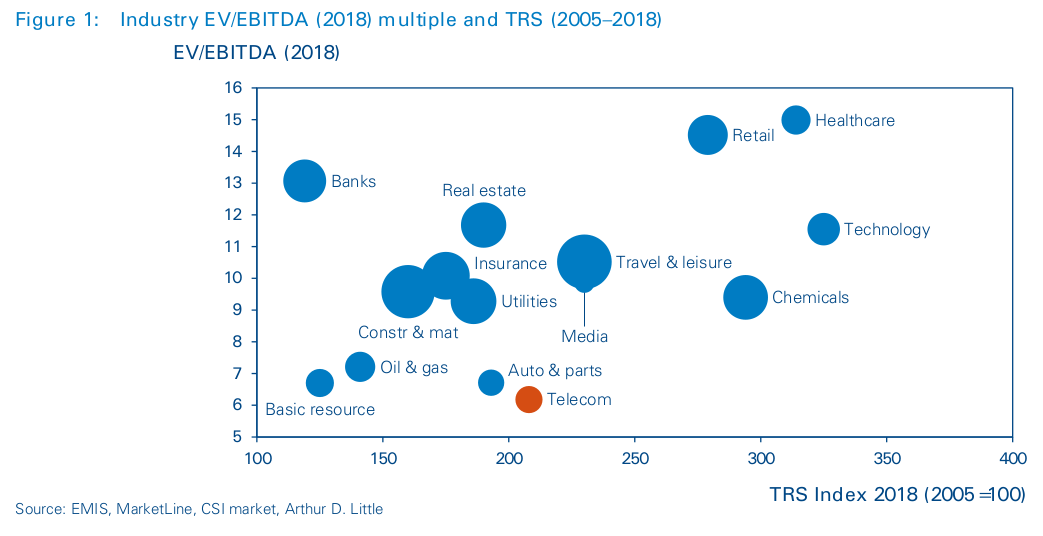
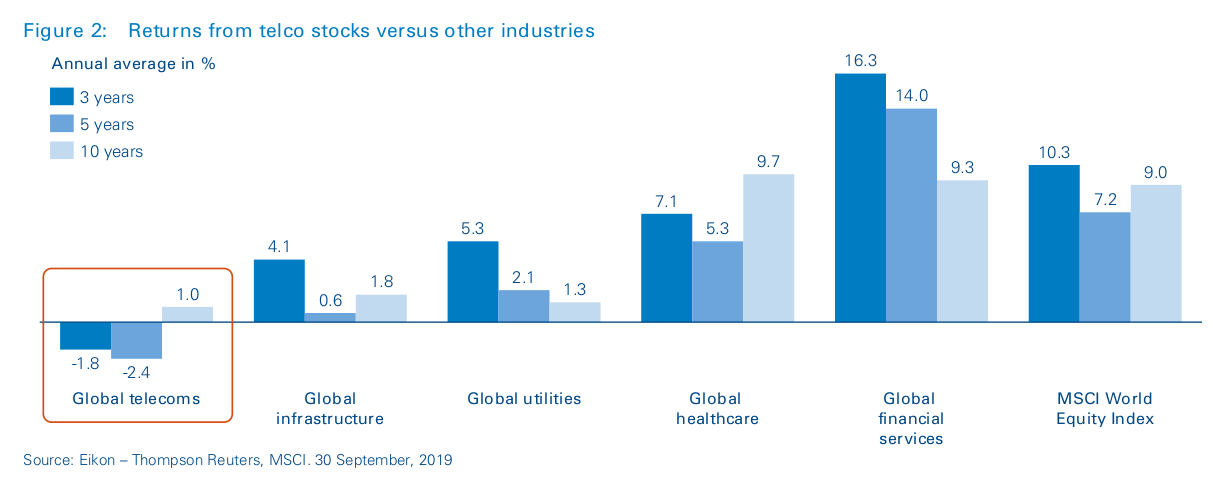
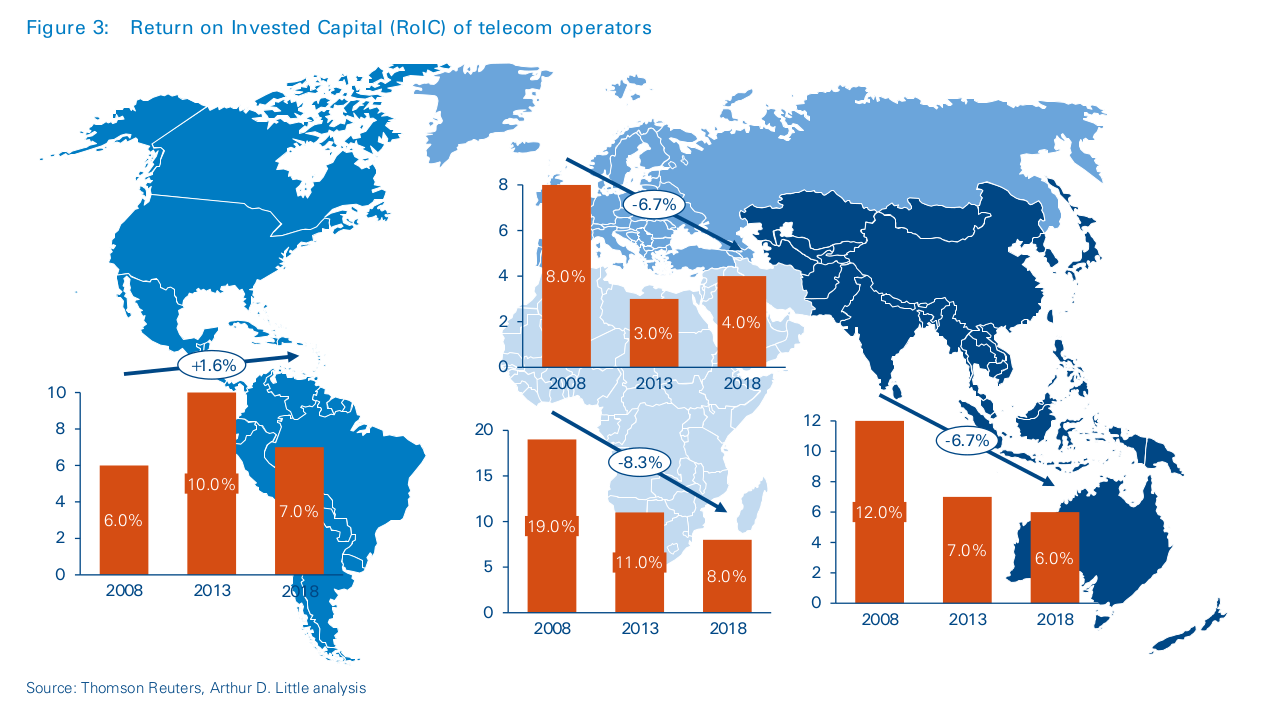
The pessimism of the stock market toward telecom operators is well founded due to their deterioration in return on invested capital (RoIC) (See Figure 3). As a sector, telecom services show RoIC that is below the cost of capital. In the US, where the cost of capital for telecom operators is close to 6.5 percent1, operators’ RoIC is in the range of 5 percent. Telcos in Africa have a RoIC of 8 percent, but when this is adjusted for the higher sovereign risk premium of 4–5 percent, even operators in Africa’s developing markets are not able to recover their cost of capital.
Comparison of RoIC with the weighted average cost of capital (WACC) of the top 10 operators confirms the telecom industry’s worst fears – only a few operators have RoIC of more than their WACC (See Figure 4). This indicates that the issues faced by the industry are widespread and not skewed by poor performances from a few operators.
The resulting low valuation of telcos, reflected in terms low EV/ EBITDA margins, deprives telcos of access to low-cost capital, which they need for additional capital expenditure if they want to remain competitive or invest in new areas for growth. It also impedes their ability to attract top talent for transformations with stock options.
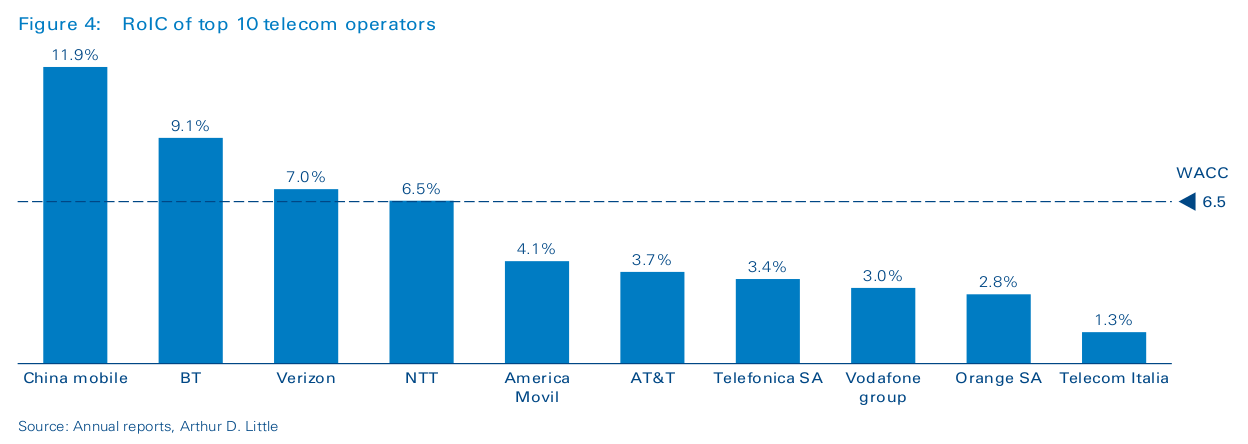
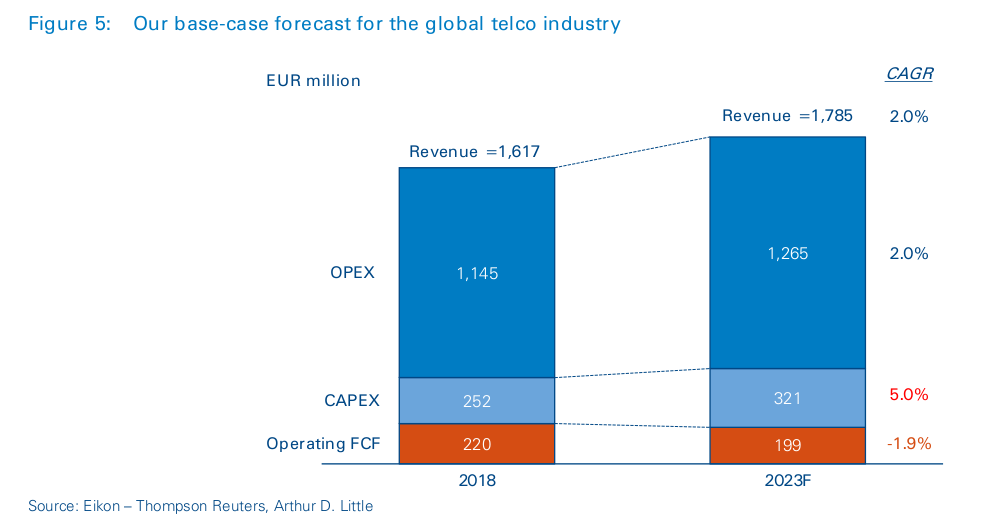
Future organic growth prospects are limited
As part of our annual assessment of the telecom industry2, we conducted an analysis on the latest available financial results from 181 telecoms operators globally, their performances since 2014, and their projected performances until 2023 (See Figure 5). The main insight from this analysis concludes:
- Telco revenues have experienced low-single-digit growth since 2014. We expect a slight uplift in revenue growth in the next five years as new use cases for 5G are rolled out, along with increased penetration for FTTx.
- Despite some revenue growth, higher capex, combined with limited opex reduction, will place pressure on free cash flow. As operators move to roll out 5G, there will be a marginal increase on capex at the same time as more and more operators are trying to outsource their network assets. This will continue to put pressure on opex.
Telcos have significant cash commitments beyond their capex: many are financially stretched because of past high capex or M&A deals that incurred significant interest and debt repayment obligations. A few telcos, especially previously state-owned incumbents, also have high dividend-payout commitments. Therefore, after considering interest, taxes, debt repayment and dividend payouts, weaker telcos have limited cash available for additional capex to improve their competitive positioning (See Figure 6).
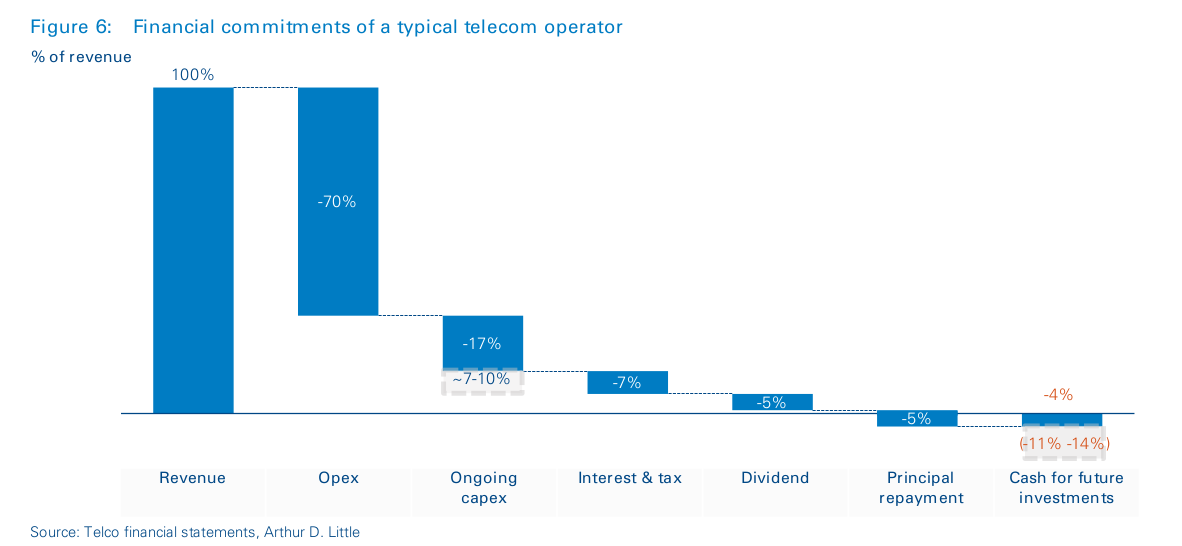
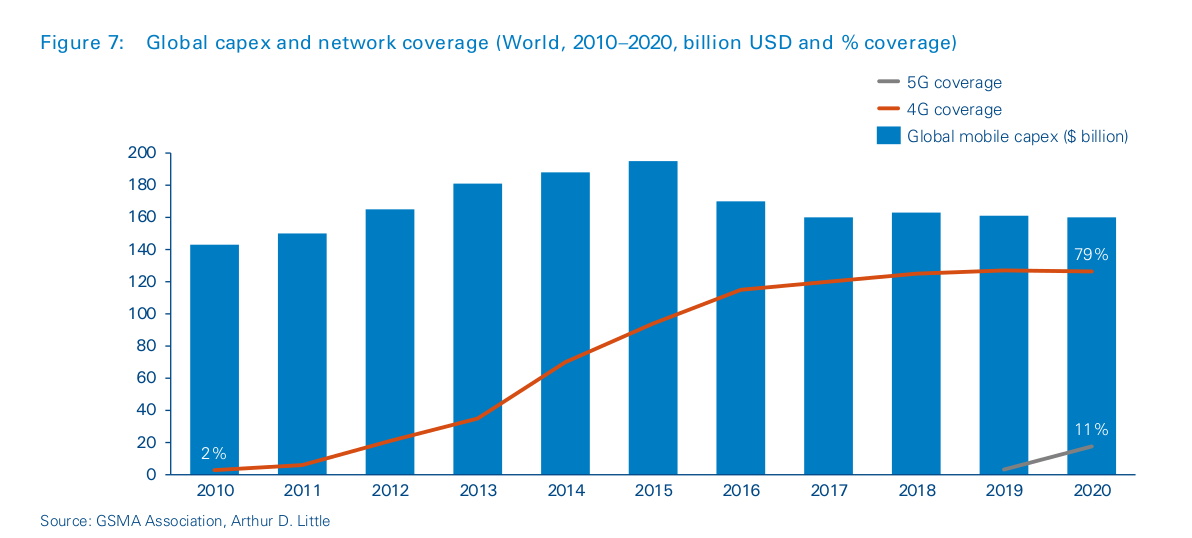
There is no let-up in capex intensity
Capex is required for both 4G and 5G, but monetization questions remain
Mobile operators lack 5G consumer devices – Apple, Google and HMD Global (Nokia) have yet to announce 5G-enabled phones. This, combined with continued growth in data traffic, forces telcos to continue to invest in 4G capacity (See Figure 7). However, they need to commit significant capital to the upcoming investment in 5G networks. In previous technology upgrades the investments required were rather modest because the new technology was an overlay of the existing network. However, 5G will require deployment of small cell and densification.
Timotheus Höttges, CEO of Deutsche Telekom, says, “Deploying 5G across Europe could require €300 to €500 billion.” This is 1.5 to 2.5 times the total investment for 4G rollout.
According to a Morgan Stanley report3 in the US (published in February 2019), the total investment outlays/commitments towards 5G have been conservatively estimated at 35 percent, 3 https://www.morganstanley.com/ideas/5G-telecoms-share-price-drivers more than that of the total investment in 4G to date, amounting to USD 68 billion. If 70 percent of incremental capex were to depreciate over 10 years, and the balance over 20 years, to account for a non-active infrastructure upgrade, the incremental depreciation would be USD 5.78 billion per annum. Depreciation over the 250 million mobile-owning population amounts to an incremental per capita spend of USD 2, which is close to 3 percent of the existing mass market spend of USD 71. However, US ARPU has been falling over the last six years at approximately 4 percent per annum. It will be challenging for telcos to recover their incremental investments in 5G from consumers, and therefore their focus should be on developing new use cases targeted at B2B customers.
Indicated incremental ARPU requirements may not materialize, as recent launches have priced 5G services similar to those of 4G (See Figure 9). Currently, more than 50 operators have 4G mobile plans with “truly unlimited” mobile data volumes in 23 out of 41 EU28 and OECD markets. This limits the immediate upside of 5G for enhanced mobile broadband use cases. Operators can monetize 5G investments stemming from other unique use cases, such as ultra-reliable low latency communications and massive machine-type communications (e.g., augmented reality and the IoT). However, this would require wider 5G coverage and customer conversions, which would take some time.

There is a widely held perception that rapid growth of IoT devices will, in turn, drive connectivity revenue for operators. European Telecommunications Network Operators (ETNO), in its 2019 Annual Economic Report4, estimates that the number of IoT connections in Western Europe will increase from 78 million to 433 million in 2023, but IoT connectivity revenues will increase from EUR 1.5 billion in 2017 to EUR 4.1 billion in 2023.
What respondents say
During our interviews in 2019, 5G was a recurring hot topic and mentioned as the main driver for change in their core businesses. One respondent said: “The 5G battle has started with a hunt for consumers and value.” Many respondents said 5G would give them opportunities to deliver new services, enable devices from drones to hospital equipment, and foster competition in areas where FTTH was not possible. In addition, it was believed that 5G would further accelerate the adoption of IoT use cases.
However, 5G monetization remains the omnipresent concern for telecom decision makers. The path from idea and use case to business case remains bumpy.
One respondent summarized the dilemma: “Data usage will definitely increase with 5G due to new use cases, but ARPU will not. It is hard to expect people to spend much more on connectivity. Yet, we have to invest, but ‘Will these additional revenues ever make the investment returns?’ remains unclear”.
FTTx rollout is still a differentiator
Because fiber-to-the-x (FTTx) is highly valued by customers, together with the possibility to offer bundled services to B2C and additional services to B2B segments, the FTTx network is a true differentiating factor. Nevertheless, the network is developed with “blood, sweat and tears”: its capex represents at least eight times that of a mobile network.
The capex required to provide coverage per household differs across countries, depending on population density and national regulations for deployment of fiber5. Even within Europe, Sweden, Spain, and Portugal have over 90 percent FTTH, whereas countries such as France, the UK, Germany and Italy have under 50 percent. To reduce capex, regulators tend to ease entry barriers by enabling infrastructure sharing. This can be in the form of duct sharing (as in Spain), fiber in verticals (France), focused areas (a rural area in France), or even entire networks. Despite the efforts of national regulators, capex remains an uphill battle for most operators.
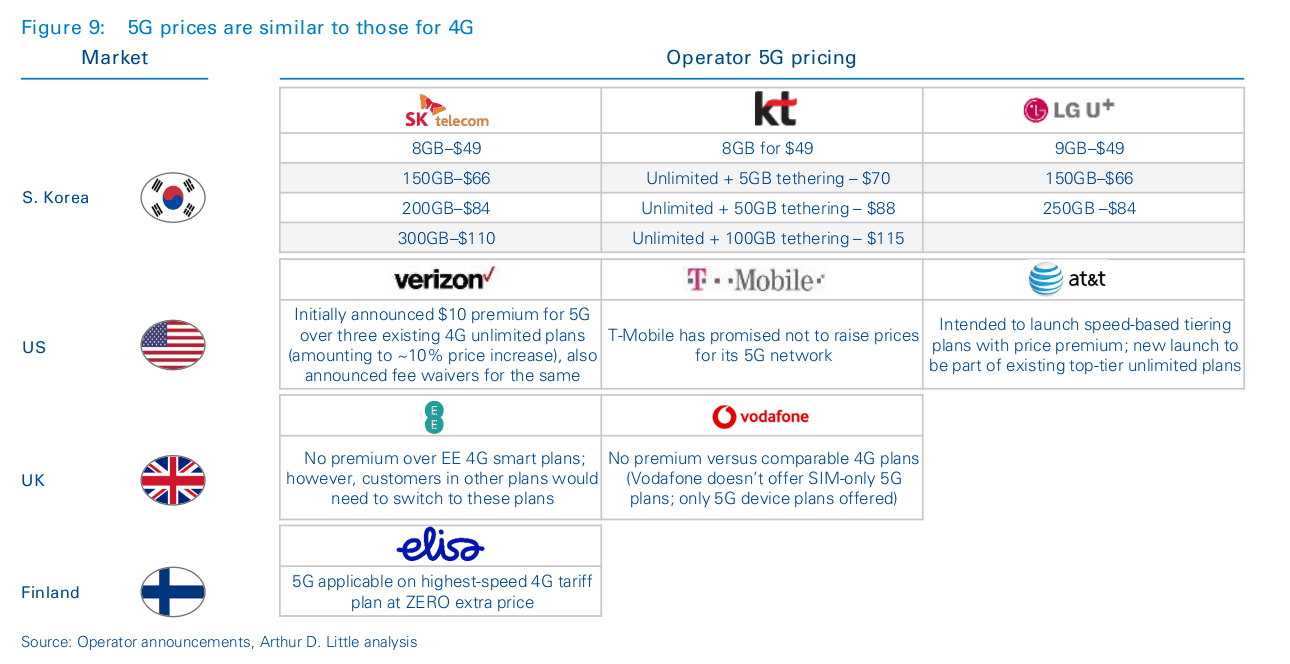
Investments in IT/NT modernization and digitalization still lag
The investment in 5G mentioned above does not include the capex required for network virtualization or the change of core network to decentralize network intelligence.
As stated in Arthur D. Little’s report published in 2018, “Delivering the digital dividend”, telcos typically invest 12–20 percent of their total revenue as capex, focusing it on networks, and, unlike internet-based companies, not directing it toward creating structural competitive advantage (e.g., Tesla’s Gigafactory, Apple’s retail network, Google’s global data center infrastructure and Amazon’s fulfillment centers). Telecom operators commit only fractions of their capex to digital transformation. To truly reinvent themselves as digital companies, they need to increase this capex allocation to digital initiatives and modify their investment strategies accordingly.
In addition, telcos do not tend to make smaller investments in higher-risk projects with potentially high rates of return. To truly transform into digital telcos, they will need to adapt this investment strategy and approach to a digital environment with digital risk/reward profiles.
Telcos face challenges in both existing business and diversification
Telcos face not only the challenge of slowing revenue growth and continued demand for high capex investment, but also a number of risks from within the industry and external sources (See Figure 10).
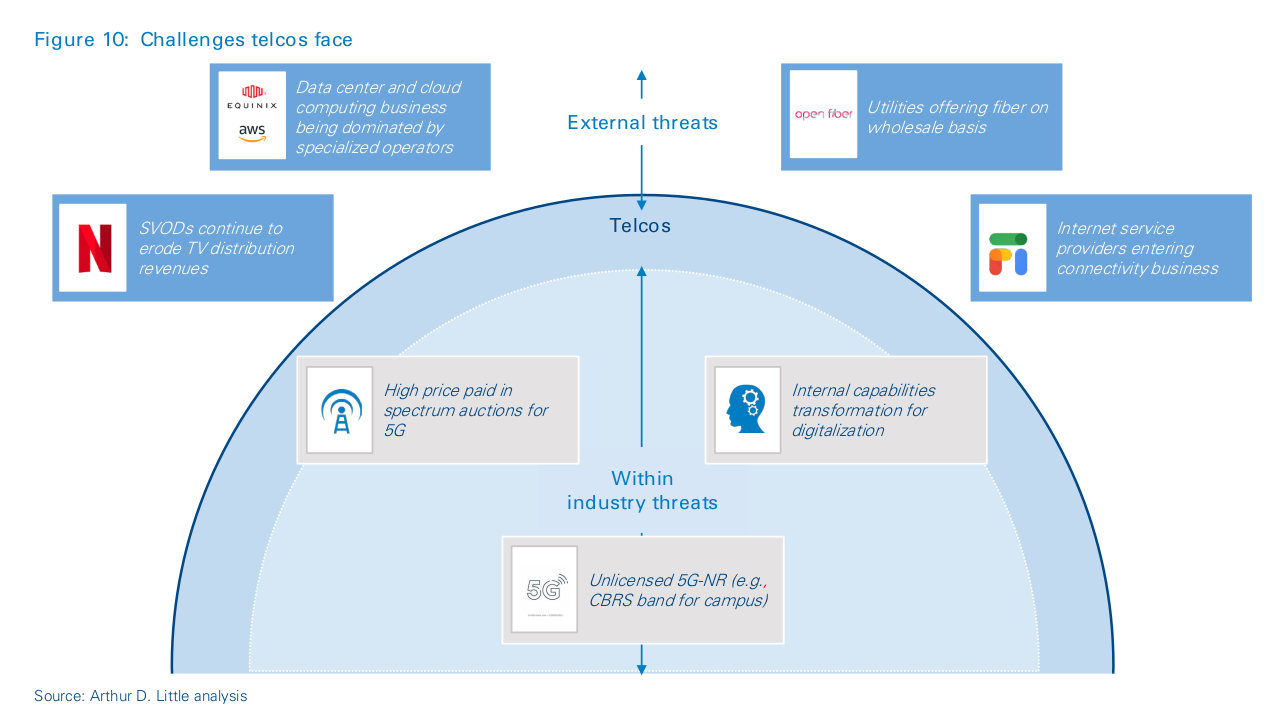
Some of the key threats from external sources include:
- The data center and cloud computing business being increasingly dominated by focused players such as Equinix and AWS.
- SVOD eating into the IPTV market – we see early signs of cord-cutting gathering momentum (at least in the US) and SVOD operators making significant investments in original content. Putting together a compelling offer takes time and investment, which will pull telcos back into the capex longhaul.
- Alternate fiber companies – many utility-based operators are choosing to offer fiber wholesale to maximize the number of homes connected as a proportion of houses passed. This could be a challenge to fixed operators planning to roll out fiber, but an opportunity for mobile-only operators that can offer fixed mobile convergence (FMC) services without having to invest.
- eSIM-based connectivity offers from internet-based companies such as Google Fi – this has been a topic of speculation for the last few years. Immediate threats from Google Fi types of services have been limited, but in the long term, telcos need to be vigilant for potential disruption.
Some of the key threats from within the industry include:
- Unlicensed 5G band – 3GPP will include 5G (NR-U6) in the unlicensed spectrum from 3GPP release 16 onwards. The NR-U network will support both the existing 5 GHz unlicensed band and the new “greenfield” 6 GHz unlicensed band. NR-U stand-alone networks in unlicensed spectrum could lead to entry of a number of local, private 5G networks dedicated to specific applications, such as industrial IoT or mobile broadband for enterprise customers. It could provide an avenue for service providers such as cable operators and ISPs, as well as neutral host service providers in public venues such as sports stadiums and malls. This could allow other service providers to offer end-to-end solutions including connectivity, and thereby potentially impact telecom operators’ revenues.
- High price for 5G spectrum – although the price of spectrum for 5G is not expected to be excessive compared to that for 3G, governments across the world have gotten used to funding the state through spectrum auctions. Spectrum auctions will remain a tool for policy makers to maximize “state” returns rather than encouraging investment in digital infrastructure. For example, Italy’s most recent 5G auction raised over EUR6.5 billion for the state.
- Continued substitution of voice international roaming by OTT VoIP – Since 2015, international voice traffic has been declining, and roaming revenues dropped after the EU implemented “Rome Like at Home”. According to a Juniper Research study7, roaming revenues are expected to stay flat over the next four years, representing around 6 percent of total operator-billed revenues and $51 billion in value.
- Internal capabilities for digital transformation – In 2018 we published a report on digitalization of the telecom industry, which highlighted how, despite the telecoms industry being a key enabler in the digital industry, most telcos considered themselves either digitally behind, or, at best, on par with other industries. The situation has not changed significantly since the report was published.
Conclusions
Telcos have been grappling with a saturating connectivity market for some time, but confluence of external and internal industry challenges will require them to take stock of their positions. With significant capex requirements, relatively lower returns, and higher cost of capital, they need to find ways to fund and build their future businesses, strengthen their core businesses, and grow in other areas. They will have to tackle multiple challenges while facing a constraint on accessing capital at attractive rates.
2
Reconfiguring assets to extract value and finance future investments
Unbundling the telco to add value for the shareholders
Telcos need to remain competitive by investing in existing infrastructure and new growth areas. The disaggregation of the telecom value chain provides an opportunity to unlock value from the company’s existing asset base. Operators need to ask the hard questions about the utility of every building block in value creation. If investments into existing and new areas are not value accretive, the board will be obliged to sell the assets and maximize the value of the firm. We have seen evidence of this with mobile towers, and are beginning to witness it with fiber. The market for telco assets has matured, and many financial investors are keen to mutualize them. Telcos are also considering new ways to slice and dice their assets to either monetize investments or reduce the capital intensity of their businesses.
Once the utility of owning the assets to meet the strategy has been determined, it is followed by a crucial step of reconfiguring the asset base to achieve the target state.
Network-wise, high broadband penetration in both mobile and fixed telecommunication services encourages a commoditization process. This further contributes to price reductions on existing products and forces players to seek differentiation in value-added services. Historically, network speed and coverage in mobile and fixed telecommunications have been at the core of battles between operators to differentiate from one another. Telcos have therefore competed to build the fastest networks with the widest-possible coverage. Consequently, in most countries there are multiple networks, which creates national inefficiencies and reduces value added for final clients, with high operator capex investments. Therefore, network consolidation of up to two to three networks is necessary for markets to benefit from competition and innovation.
As the network gap has reduced to similar coverage and capability between operators, differentiation factors must be found elsewhere. It can be argued that in consolidated markets, when end clients finds themselves with two to three operators offering the same mobile coverage and FTTH, decisions are based on price, customer experience or value-added services.
Operators have numerous opportunities to monetize their assets, including mutualizing ducts, dark fiber, mobile towers, RAN and small cells. This is made possible by new sets of investors, such as private equity, pension and infrastructure funds, which are well acquainted with the risk/return profiles of telecom infrastructure.
Owning and operating such a diverse set of infrastructures under a single telco is not only a strain on management focus, but also financially inefficient. The separation of infrastructure from the traditional business pushes each organization, the MNOs, and the network companies to focus on what they are best at. On one hand, the network company is focused on maintaining and upgrading infrastructure, improving coverage with the newest technologies, and seeking deployment efficiencies. On the other, MNOs (Retailco) still compete in the market and are able to focus on adapting their offerings to changing client needs.
Valuation impact of divergent telecom profiles
As we outlined in our 2016 report, “Major strategic choices ahead of telcos: Reconfiguring for value”, many telcos are seeing valuation decreasing year after year. Market competitiveness fueled by product commoditization is decreasing future outlook for businesses, and investors are looking at telco infrastructure. While integrated telcos are valued at 5–6 EV/EBITDA and going down, NetCos are valued at 11–17+.
Difference in valuation is mainly explained by the different risks the investor undertakes. NetCos have the vast majority of their income ensured by long-term contracts (15+ years), and thus predictable cashflows, while traditional telcos have to deal with short client contracts, churn and innovation risks. NetCos’ relative security enables them to tap into vast financing capabilities held by low-risk investors such as pension funds, infrastructure funds and private equity, which increases investor competitiveness and therefore infrastructure valuation.
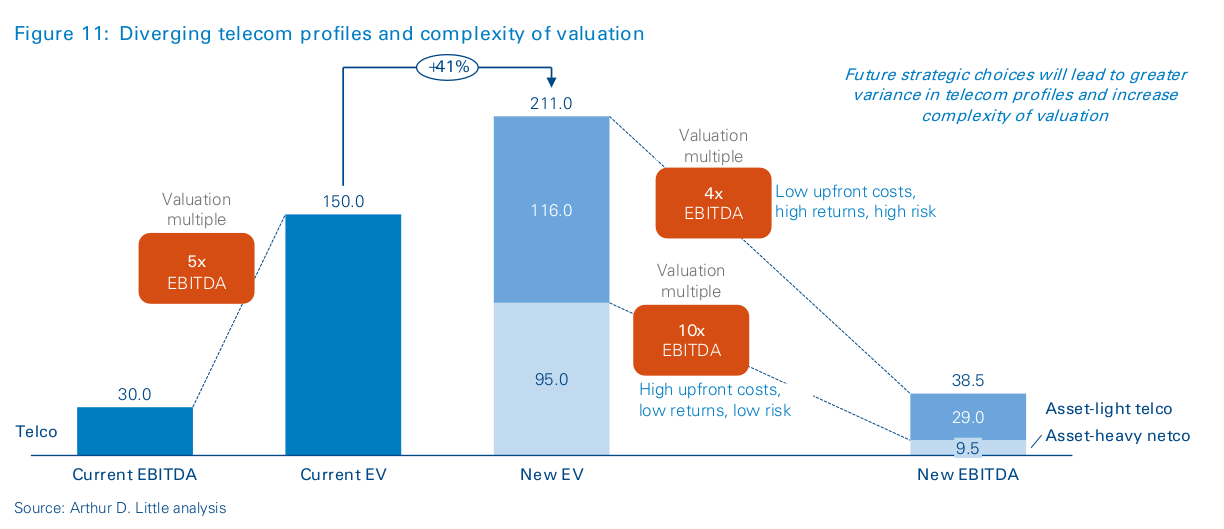
Additionally, NetCos can increase their income by reselling spare fibers to competitors, as well as other types of players (such as OTT players and financial institutions). A separated NetCo increases in value for the same financial reasons as in the case of mobile towers. As an example, Chorus in New Zealand separated its network from Spark in 2008 because it had won most of the government’s fiber deployments, aiming to become a national network wholesaler, and the government had imposed the separation. Initially, its shares traded as low as 4–5x EBITDA, but have since grown to 8x EBITDA due to a clearer regulatory backdrop emerging.
Reconfiguring assets: Options for shareholders
Disaggregation of the value chain creates divergence in valuations of different asset classes (See blue box page 19: “Valuation impact of divergent telecom profiles”), as many telco assets are used more efficiently through increased sharing in the hands of new owners. Therefore, boards will find restructuring of telcos increasingly important. External investors, such as hedge funds, will be tempted to invest in telecom operators to unlock the value of the assets they hold.
As segregation of the telco value chain is better understood in the market, private equity/investment firms see arbitrage value by hiving off the different assets of the telco into separate companies, where the value of individual parts is more than that of an integrated telco. Elliott Management, a hedge fund, launched a bid for Telecom Italia in 2018. Elliott detailed the reason for the separation of Telecom Italia, which was based on segregating its assets into different entities (See Figure 12).
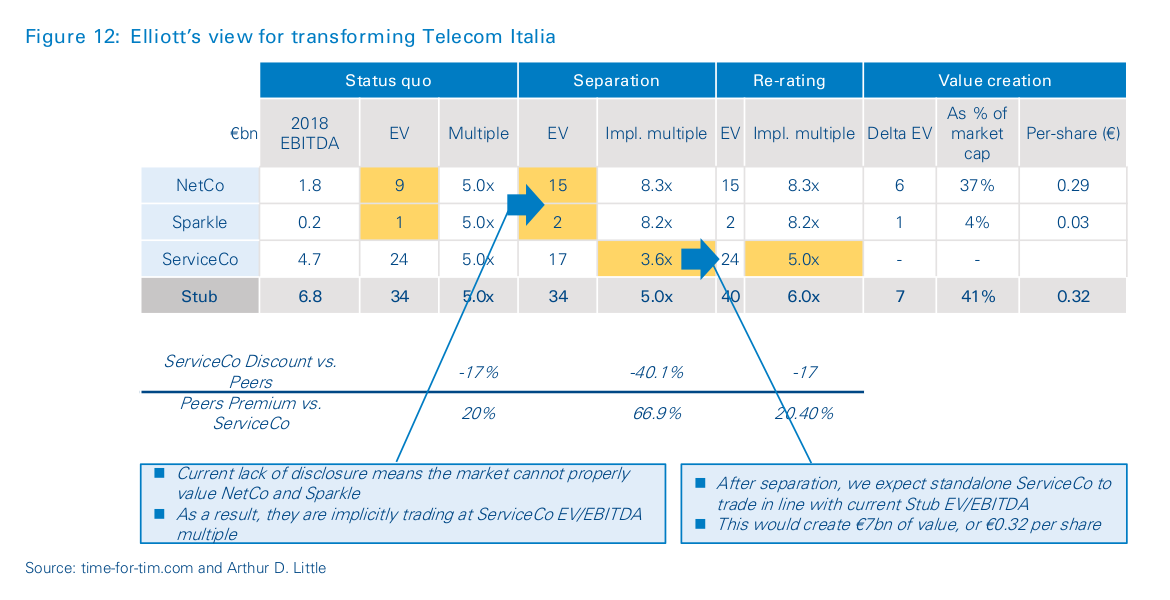
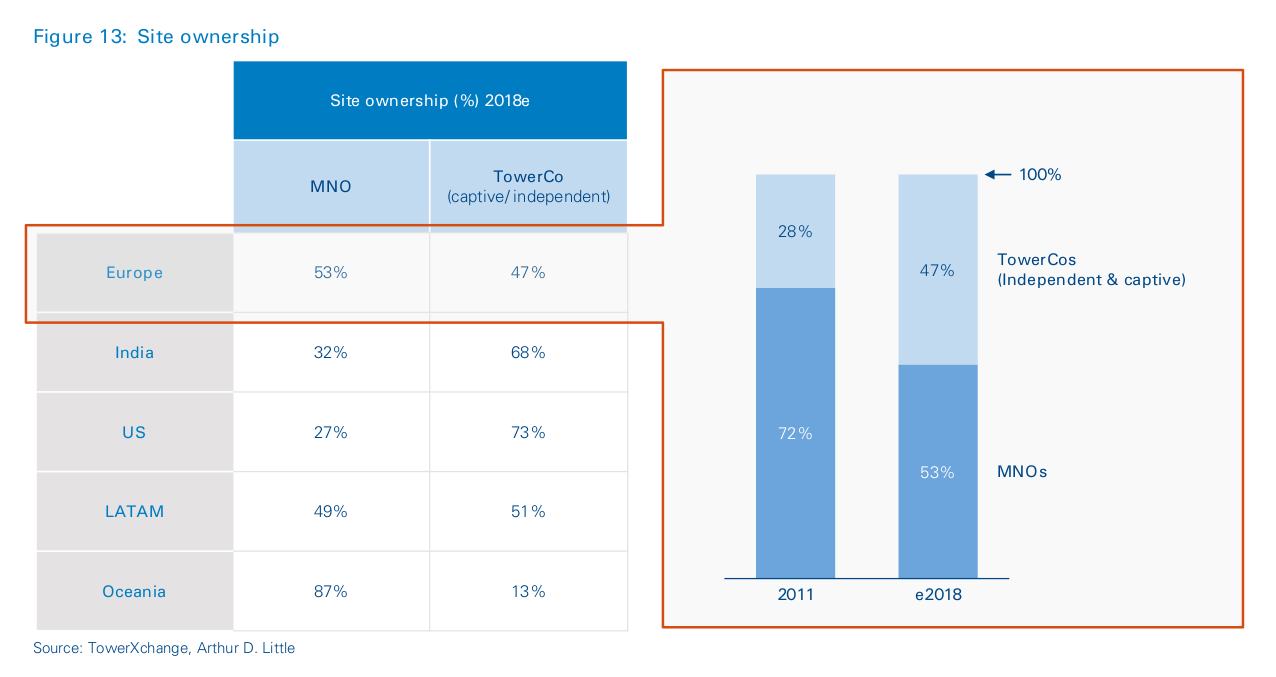
Reconfiguring key telco assets – Towers and fiber
The boards of many telecom operators have been reconfiguring assets by separating off mobile towers, as well as fiber assets in specific cases.
As many mobile networks have similar footprints, the synergies ,from tower consolidation are obvious. Therefore, there has been rapid growth in the mobile network consolidation market in the last few years. Whereas only 28 percent of European sites were owned by TowerCos in 2011, by 2018, 47 percent of all mobile sites were carved out from MNOs to become either captive or independent TowerCos (See Figure 13). The US and India are leading this trend.
Tower companies are providing higher returns than telecom operators are, as efficiency increases and long-term cash flows are ensured when assets are shared among operators (See Figure 14).
As more and more operators relook at the infrastructure arena, they are widening the infrastructure market by tapping into sunken assets to improve their performances. Although global markets are at different maturity levels, they are all increasingly looking at passive and active assets as actionable levers. When comparing infrastructures, mobile networks stand at the forefront of market development. This is because competitors have reached similar coverage earlier, which has reduced their network differentiation value.
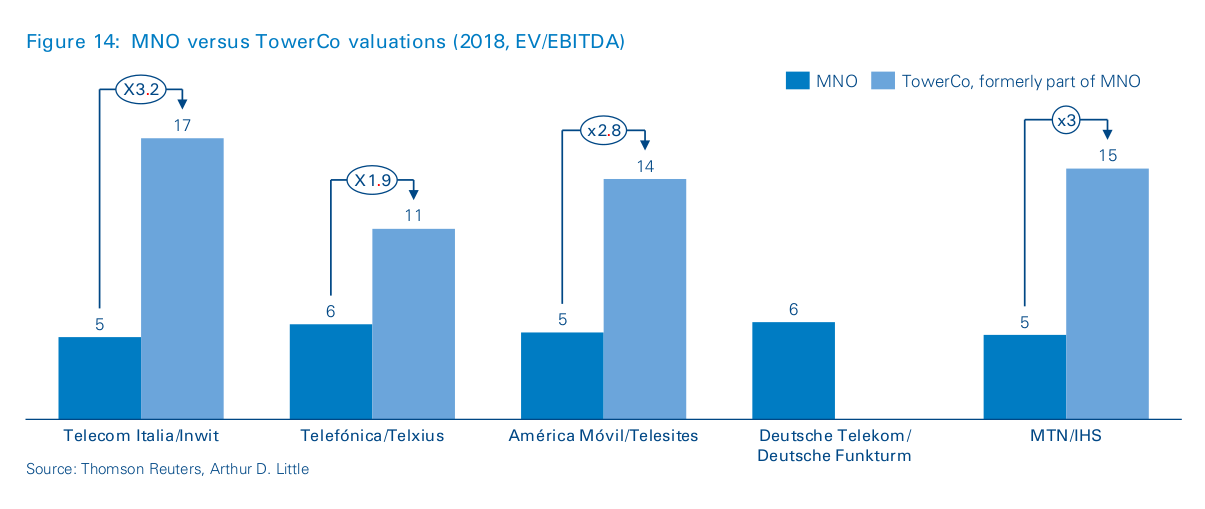
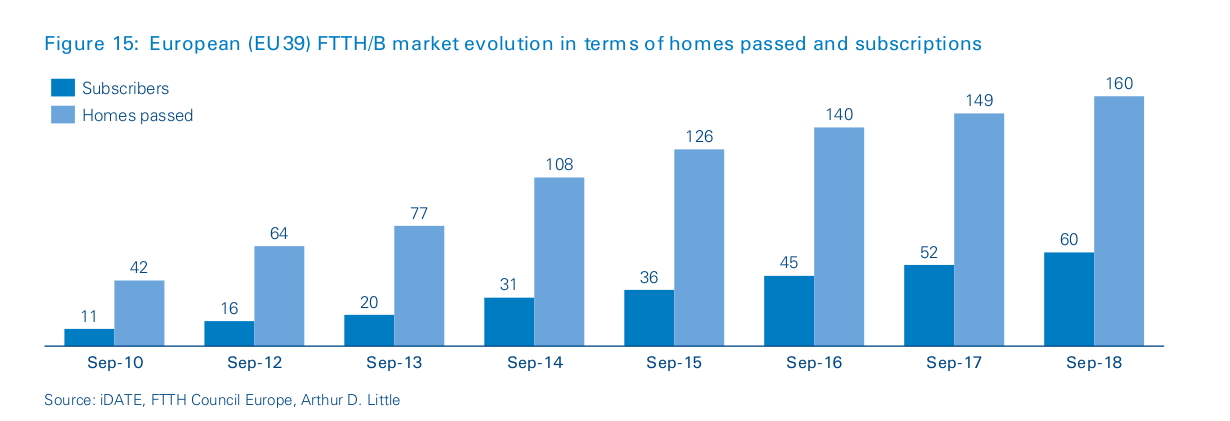
The FTTx network is likely to be the next network asset to be mutualized as it is underutilised with relatively low levels of subscriptions of the homes passed (See Figure 15). Similar to with mobile towers, the high value of fiber assets, along with certainty of cash flows, is leading to an increase in transaction prices for such assets and creating large financing options for operators. Additionally, a NetCo can increase its income by reselling spare fibers to competitors and other types of players (such as OTT players and financial institutions).
As fiber wholesale models become increasingly prevalent, investors are now attracted to financing fiber rollout from the inception stage. Telcos are also becoming more sophisticated in their involvement of infrastructure funds, offering different parts of their fiber networks to specific types of investors. In these cases the cash flows and risk/return profiles of the businesses match those of the profiles of the investors. Now, fiber networks are being apportioned into fiber-to-the-antenna (FTTA), fiber-tothe-office (FTTO), metro fiber and fiber in the core networks (See Figure 17). These deals are becoming more and more common – in 2018, TelePacific in the US sold and leased back metro fiber to Uniti Group, a telecom real estate investment trust. Altice France has sold a 49.99 percent minority stake in fiber-optic business SFR FTTH for $2.05 billion to Allianz, AXA and Omers Infrastructure.
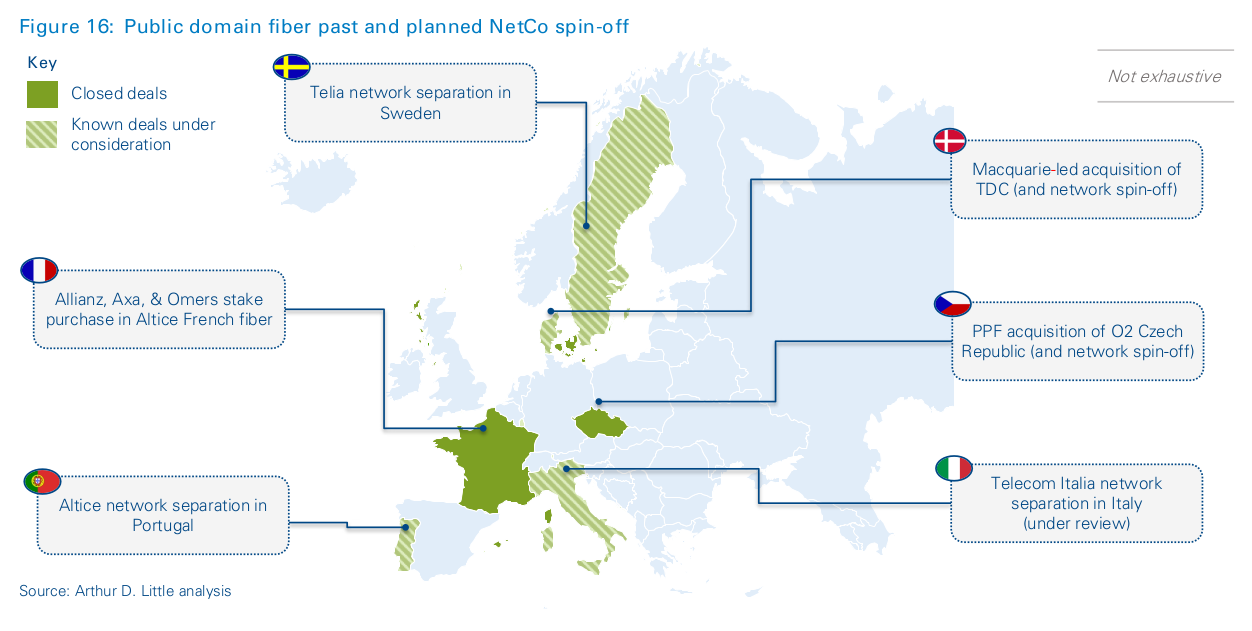
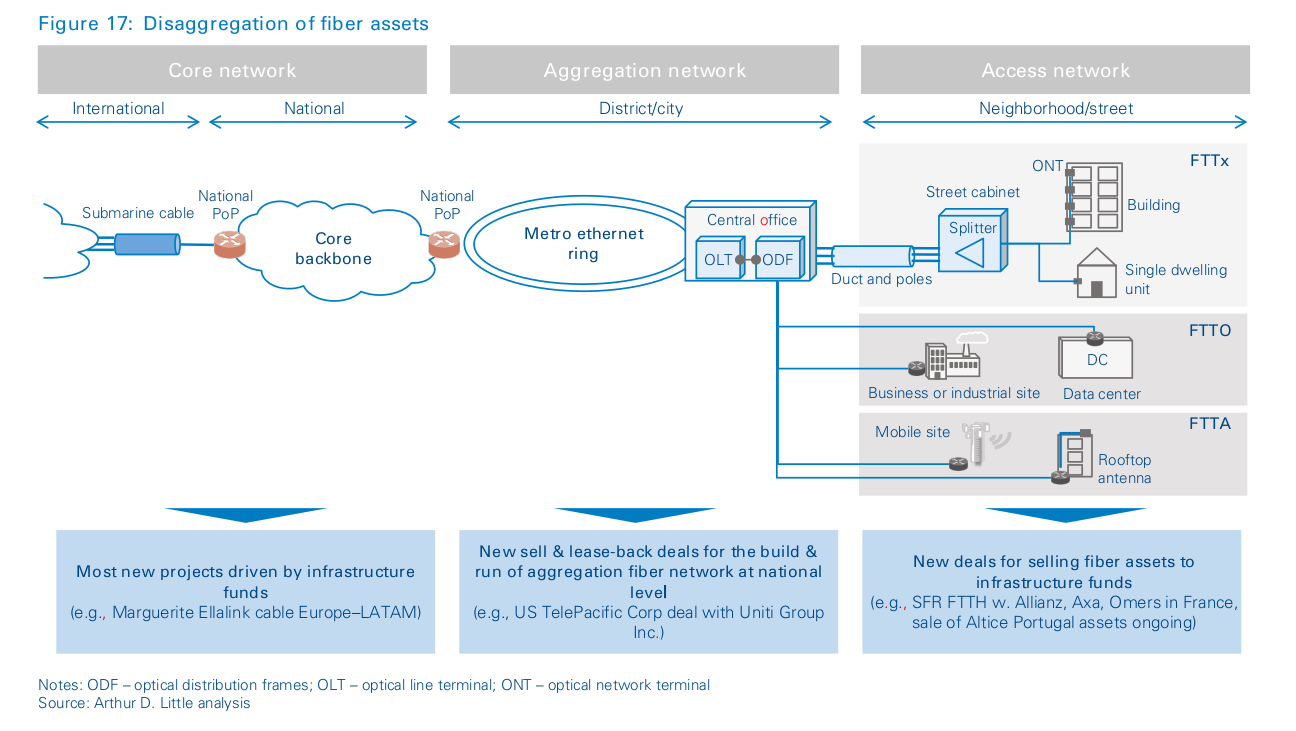
A similar opportunity exists in offering 5G capacity to specific customers using network slicing. Telcos can form joint ventures with organizations which would normally roll out their own dedicated networks (e.g., utilities and government agencies). With these deals, telcos can also use the organizations’ spectrum and, in return, offer dedicated capacity (See Figure 18). This type of an arrangement is mutually beneficial, as the telecom operator gets access to spectrum and steady cash flows, and the government agency gets a state-of-the-art telecom network with very low maintenance overheads. It is also acceptable to regulators because it leads to more efficient use of spectrum.
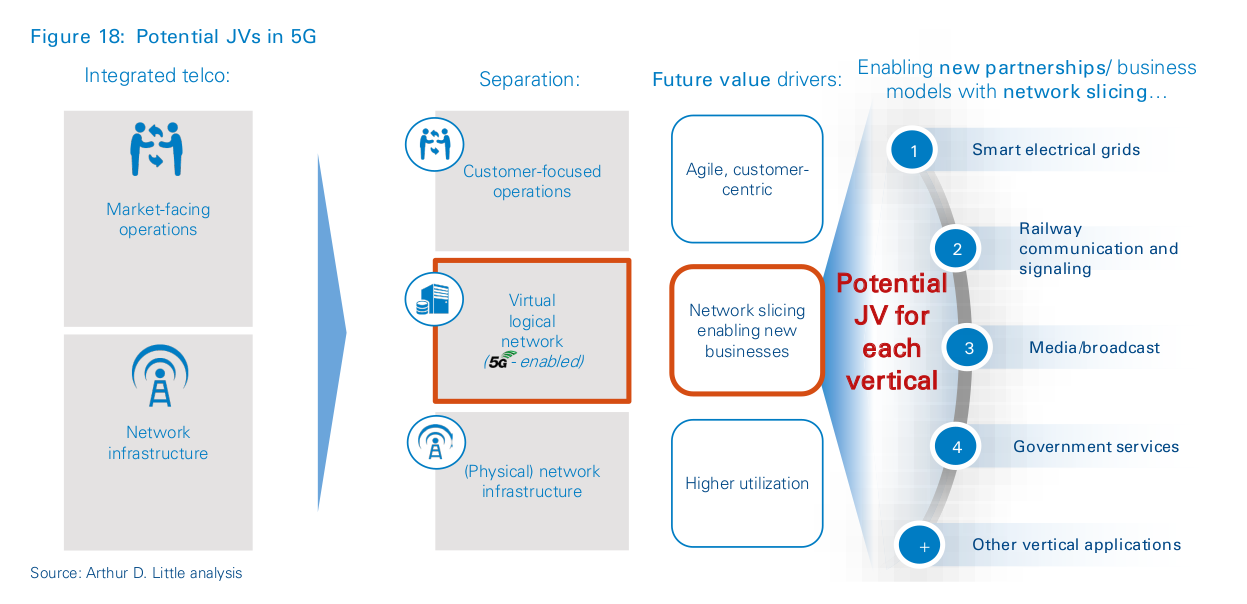
Case study – Cellnex Telecom: A success case
Cellnex Telecom (formerly Abertis Telecom) has consolidated as Europe’s largest TowerCo, with a solid track record of M&A across the continent. The company has evolved through inorganic growth, from a local, mono-product Spanish company offering broadcast services, to a multinational group with a diversified product portfolio.
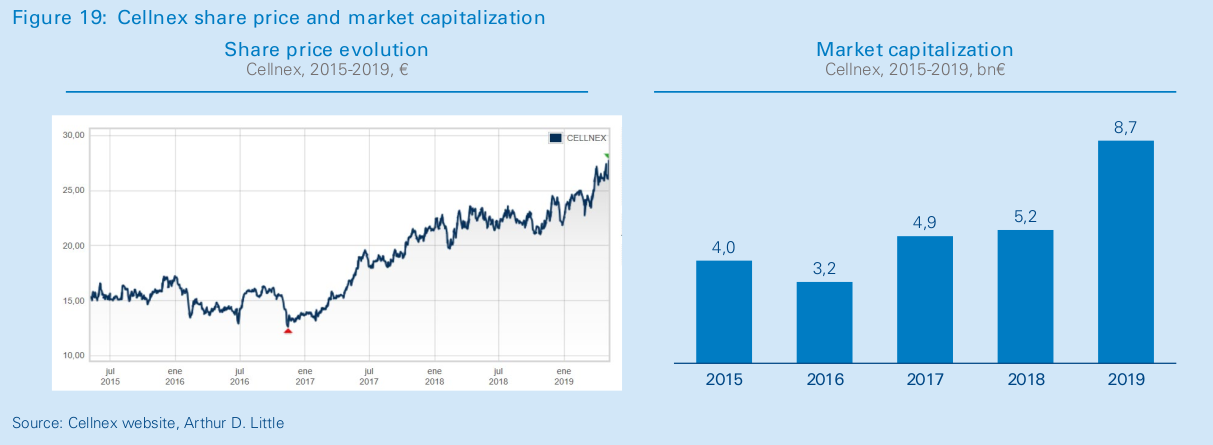
On the buyer side, Cellnex has acquired assets from major European operators:
- In Italy, from Iliad and H3G, which then merged with Wind to form the third-largest operator in the country.
- In France, from Bouygues Telecom and Free, which has allowed the independent TowerCo to consolidate national networks.
- In Switzerland, from Sunrise and Salt, which has given it the opportunity to consolidate networks.
- In Spain, from Telefónica and Masmovil.
Cellnex has become a lighthouse for infrastructure acquisition due to its European expansion. In four years the company has reached European presence in six countries, and its market value has increased at each acquisition. While its price per share has increased from EUR15 to EUR27 between 2015 and 2019, its market capitalization has rocketed from EUR3.994 million to EUR8.658 million in the same period.

Conclusions
Telcos can take advantage of the disaggregation of the value chain to mutualize their assets. Mutualization of assets creates an opportunity for telecom players to monetize their investments as financial investors find them attractive. In recent years, the market for telecom infrastructure assets has gained in both depth and breadth among investors. Telcos should consider this opportunity to generate the necessary cash flows to invest in their core and future businesses by spinning off non-differentiating assets. If they do not move to efficiently use assets that are commensurate with their business models, infrastructure funds and private equities will look to disaggregate them. The key challenge for telcos is to decide the types of assets they want to hive off and, at the same, avoid losing control over the use of such assets.
3
Embracing the future: Must-haves to complete the unfinished agenda
Telcos of the future will be more heterogenous
Telcos of the future will have to not only tackle disruptions of their value chains, but also identify areas in which to compete and differentiate in the disaggregated value chain of infrastructure, platform and services layers (See Figure 21).
Each layer offers its own set of challenges and opportunities. As there are varied possibilities across the different layers, the telcos of the future will be significantly more heterogenous than they are today. In the future, operators could be simple, efficient, network-based connectivity/infrastructure providers, or they could be diversified players offering a range of services, such as banking, media and IT solutions, in addition to connectivity.
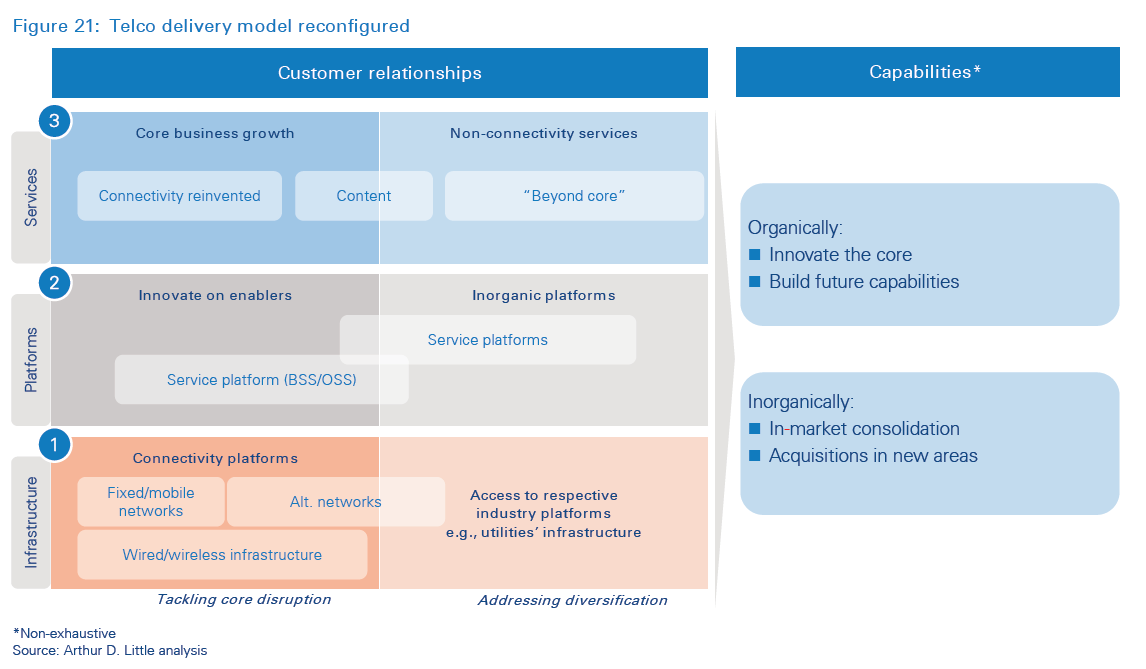
Infrastructure layer: Reconfiguring the infrastructure
- Provisioning of connectivity services is increasingly converging at the network level, and softwarization of networks across multiple layers is triggering a need for examining stand-alone plays.
Platform layer: Developing platforms that drive agility and digitalization:
- Digitalizing and adopting newer production/operations architectures are a hygiene factor to stay “in the game”. Operators can build on such capabilities to offer tailor-made solutions (e.g., industry-specific IoT solutions).
Services layer: Battling for customer relationships:
- The battle for customer relationships in saturated communications markets drives the need to deepen the relationship by providing convergent bundles, value-added services, and branching out into altogether new territories in terms of customer relationships (e.g., banks).
- This, in turn, drives the need for not only the platforms needed to serve customers, but also the underlying people capabilities that can deliver this aspiration.
- Even within the same customer relationship, new business models have to address emerging customer needs with effective monetization, which may include working with the broader ecosystem to target the same customers.
Depending on its strategy, a telco could focus on only one layer or a sliver of layers to develop a defendable position.
- “Bitpipe” – A broad cost leader: An operational- and capital efficiency-focused connectivity player with efficient cost leadership, which succeeds by serving a broader market. Examples include pure service players with lean assets that already have or are achieving scale plays.
- “Niche” – Focused cost leadership and differentiation: Operations that focus on customer segments anywhere within the value chain. Examples include spectrum holders, virtual operators and passive infrastructure players.
- “Global/regional ICT plays” – Differentiated: A differentiated ICT player with varying degrees of service-level diversification, which uses scale possibilities in every target market/segment.
- “Diversified” – Differentiated with deeper customer relationships: A player aiming for success by being present in multiple industries, aided by deep customer relationships and betting on cross-industry diversification opportunities.
Transitioning from existing connectivity-based focus to the desired state requires a telco to define its target state based on its local circumstances, and then execute the unfinished agenda and pursue inorganic approaches to find growth (See Figure 22).
Must-haves - Innovate the core and complete the unfinished agenda
In our review of the strategies of the top 10 telecom operators in their 2018 annual reports, the top three priorities for telcos related to organic options (See Figure 23). Telcos must remain competitive in their core offerings by investing in 5G/FTTX, IT/ network technology, and brand. At the same time, they need to build capabilities required for the future, which include being digitally enabled, commercial excellence, and partnership management capabilities. In addition, customer experience and cost optimization are far from being completed.
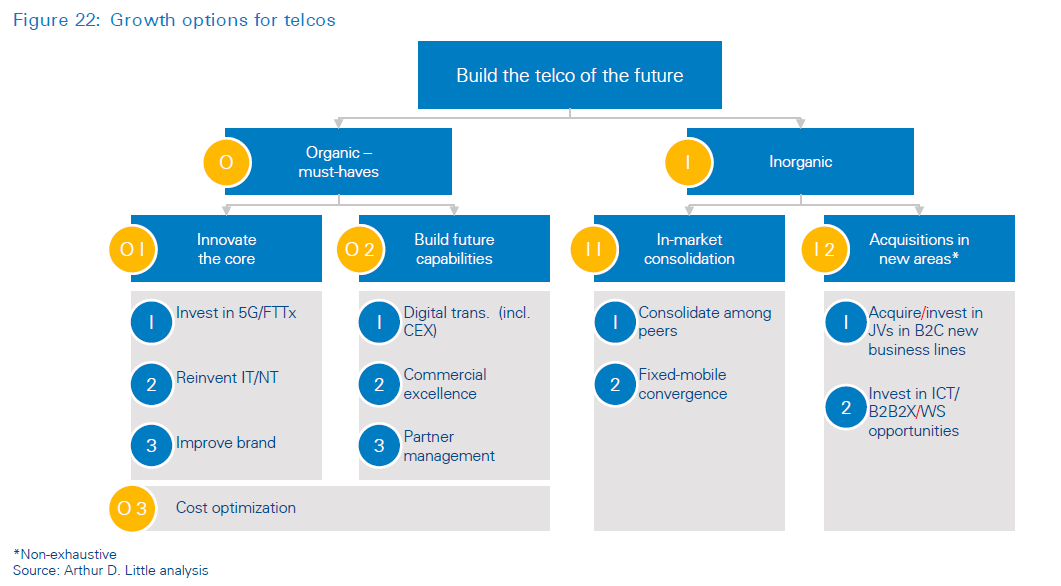
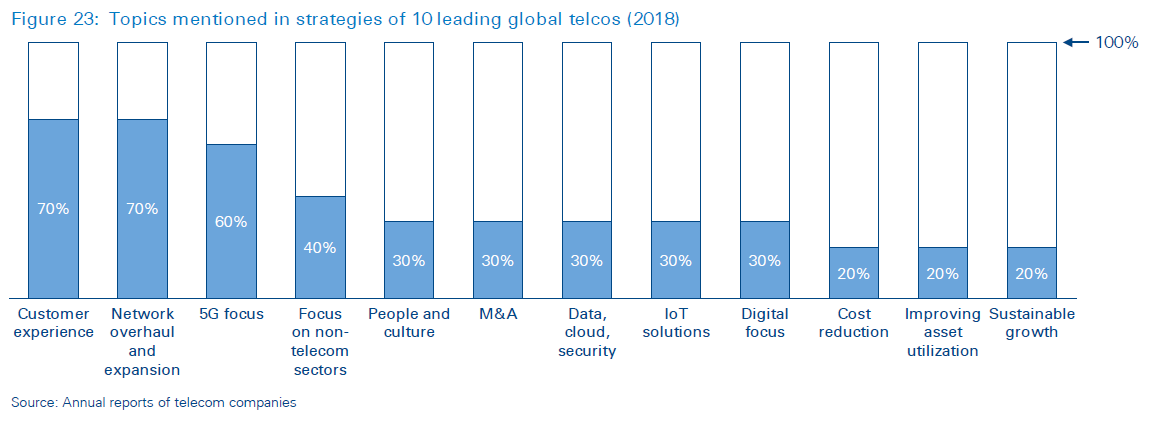
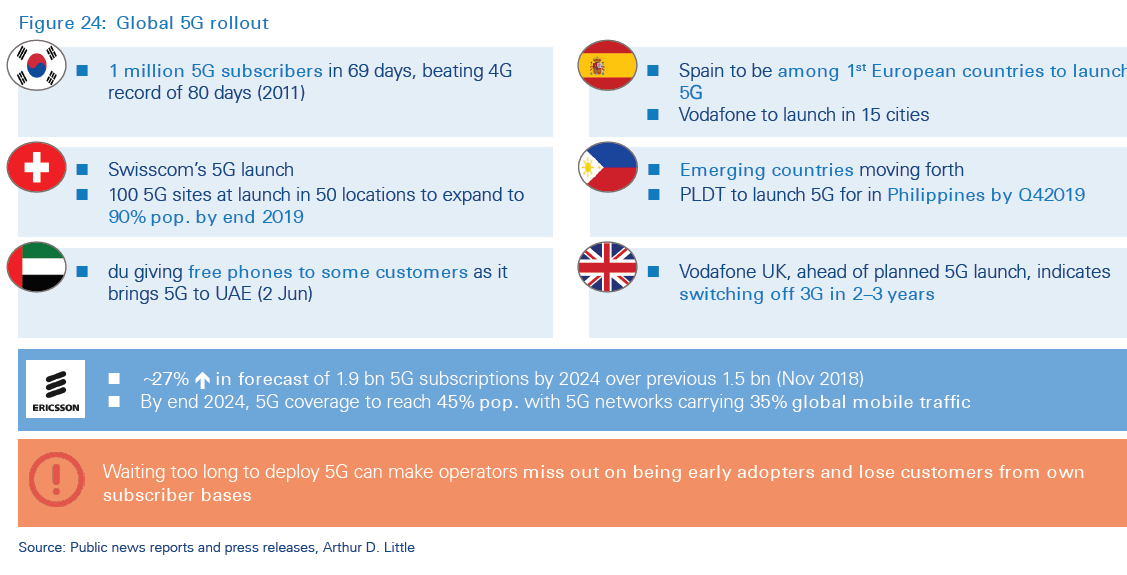
Investing in 5G and FTTx is a necessity
There may be uncertainties about the economic viability of 5G rollout, but on the ground 5G is fast becoming a reality across the globe. It is an inevitable industry race for operators to follow, or they will risk losing key customers (See Figure 24). Waiting too long to deploy 5G can make operators miss out early adopters and lose customers from their own bases.
As stated in our report, “The race to 5G”8,8 although many countries have started to deploy 5G networks, only a few are focusing on the traditional mobile mass market (consumers) to enhance user experience. Overall, we see the three deployment models – gigabit broadband to the home, industrial digitalization through corporate networks, and digital industrial use cases – as the key uses triggering most 5G network advancements. Since in these use cases customers are located beyond central business districts, telcos will be required to roll out 5G networks to remote areas. This will require significant investments.
As mentioned above, many countries lag in FTTx rollout because they have good-quality cable networks, or incumbents that are slow to introduce fiber because they want to maximize returns from their existing copper networks. Some countries that have low fiber penetration risk entry of wholesale-only providers. A report by Barclays (See Figure 25) states that Germany and the UK have the most potential (risk for incumbents) for entry of alternate wholesale operators (similar to Open Fiber in Italy). Open Fiber has been rapidly increasing its market share through a wholesale model. Therefore, fixed operators will have to decide to accelerate their investments in FTTx or risk being left behind by this model.
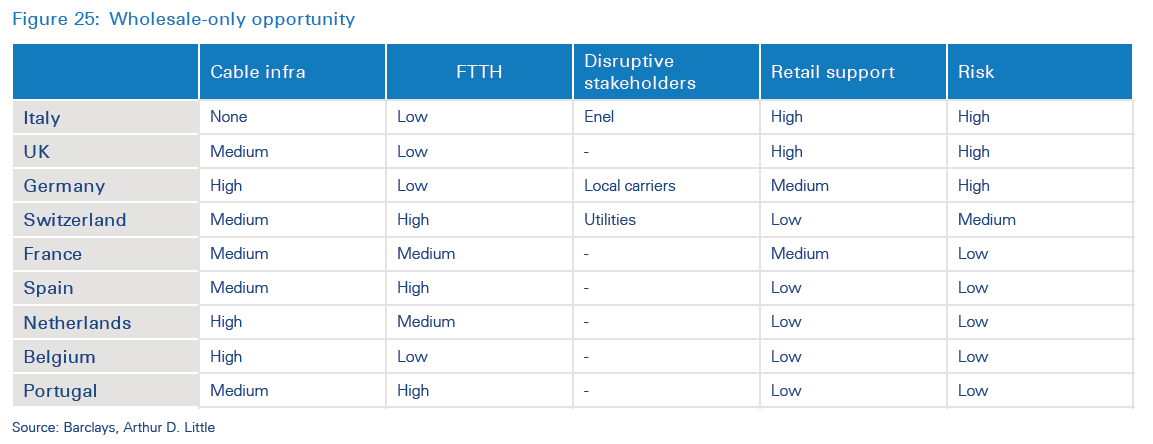
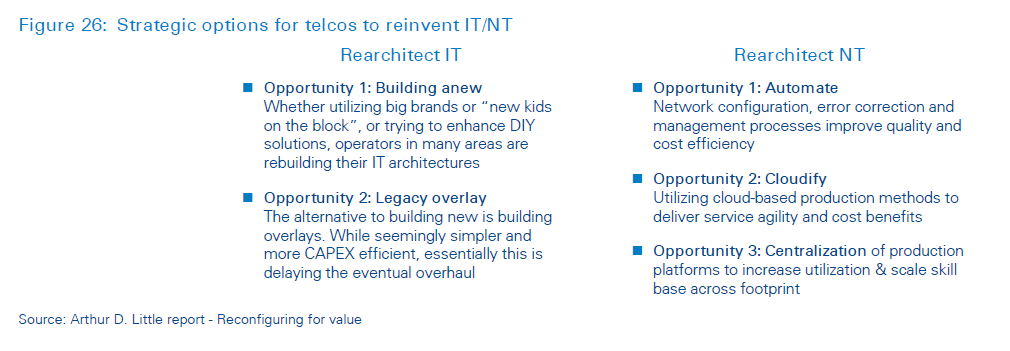
Reinvent the IT/NT
The ability to scale out services will gain importance as operators transform their production models to reach beyond their network footprints. We anticipate dynamics occurring in three ways:
- Operators managing other carriers’ networks in noncompeting territories.
- Operators integrating with other networks to address the needs of multinational customers beyond their own network footprints.
- Operators allowing other carriers to use their own networks, with less manual intervention in the process.
We continue to envision a world in which operators compete in markets well beyond their own network assets and reach, but still utilize their operational support system (OSS) and business support system (BSS) platforms. The network operator’s competitive environment will change: web-like collaboration possibilities will drive competition on a global scale and, as such, may drive further consolidation. This will require telcos to restructure their IT and network technologies (See Figure 26).
As networks are increasingly virtualized, their design and development activities start to resemble application development within their IT organizations, even though the required skills and competencies continue to differ to some extent. Operators need to change their approaches to organization design in order to address these converging functional requirements. We see the technology organizations of telcos transitioning9 from the current (and often independent) structure of network and IT verticals, to infrastructure and application layers. This will possibly be followed by highly integrated technology organizations.
Reinvent the brand
As per Brand Finance109, the five most valuable brands are Amazon, Apple, Google, Microsoft and Samsung. AT&T and Verizon are in the top 10 and have increased their value by an average of 8 percent over previous year. However, other large telcos have not performed well; both China Mobile and Deutsche Telecom fell by three places in their rankings in 2019. NTT fell by nine more places. There is a challenge for telcos, as they are perceived as utilities offering only connectivity services. As telcos enter new areas, they will have to spend considerable effort and resources to rebrand themselves as more than utilities and show that they offer a range of services.
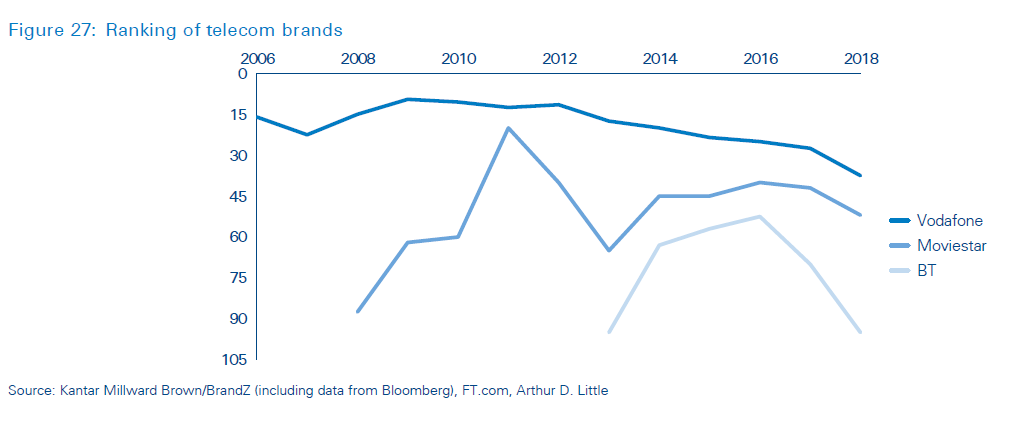
Telco rebranding has multiple aspects to it. It is more than just rebranding the company’s main logos. As telcos offer increased ranges of service and target specific customer segments, they need to consider multiple-brand strategies, which require all marketing and product offerings to be aligned. A few telcos are in the process of launching sub-brands. For example, Vodafone launched Voxi, a SIM-only brand. Similarly, the Vodafone enterprise was recently rebranded as Vodafone Business. The enterprise previously had no external logo. Iris Meijer, chief marketer of Vodafone Business, commented10: “Customer centricity is a concept that has stood the test of time. When we began to explore the idea of our brand refresh, reaching out to our customers from the home office to the boardroom, each was worried about the same thing: digital transformation. We have known for some time that our customers want a partner to join them on their digital journey, a partner they can trust.”
Build future capabilities to make telcos sustainable
Digital transformation and customer experience are crucial for both survival and growth
Digital transformation opportunities exist across the telco business model. Globally, major fixed and mobile operators have engaged in digital transformation, embedding digital initiatives at various maturity stages within different parts of their businesses. The results of our survey show this disparity of digital maturity. They also indicate that despite being key enablers in the digital industry, telcos consider themselves at the beginning of the digital transformation journey.
Even in diversification, telcos’ core capabilities matter – probably even more than usual because diversification should never be an arbitrary move. The key challenge remains integrating “different market” businesses into the existing portfolio to create a sustainable and defendable whole business. Telcos need to leverage digital capabilities they have developed for their own core business processes, and build upon them to move into new industry verticals. Once they have developed superior services, this can be productized and adapted to different geographies and client segments.
Telcos have long realized the strategic importance of customer experience, yet translating this strategy into action and tangible experience for customers is long overdue. Telcos face increasing competition from in-market players, as well as OTT players with digital-first approaches enabled by software capabilities, new-age skills and customer-obsessed mind-sets. In such a hyper-competitive context, customer experience is arguably the most fundamental lever for telcos’ survival. However, the challenge is ever-increasing customer expectations, driven by customers’ exposure to a range of digital-native services across ecosystems. This exposure makes the difference between the experience delivered by digital-native players, and that from telcos, extremely striking.
For example, today’s customers enjoy the option of configuring and customizing their purchases in line with their needs via digital channels (e.g., staple service configuration), but they have to pick and choose from preset mobile data bundles or tariff plans. They can expect their food orders be fulfilled in less than 60 minutes (delivery promised by Deliveroo), but they must wait for days for their sim cards to be delivered. They enjoy real-time transparency on product/service orders (e.g., Uber), but not when it comes to home broadband service installations and activations. They enjoy extreme responsiveness in complaint/service failure resolution (e.g., Royal Bank of Scotland predicts and resolves customer issues before they are even raised), but are promised three working days to have their telecom service disruptions resolved. In summary, telcos must seek inspiration from players operating beyond traditional industry boundaries, as their customers’ expectations are fueled and shaped by new benchmarks in customer centricity.
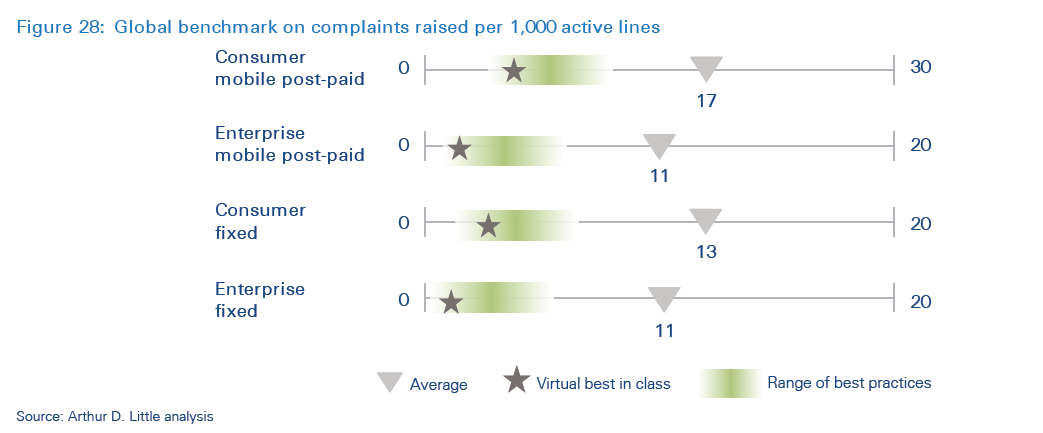
Our global benchmark indicates that a typical telecom operator’s customer raises more than twice the number of complaints as the industry best-in-class (See Figure 28). Telcos should use digital transformation to continuously reduce the volume of complaint incidences and radically improve the speed of complaint redressal.
Commercial excellence needed to find opportunities of the future
Telcos must continue to invest in their infrastructure and develop digital capabilities, but to monetize such investments they will also have to build commercial skills to help them identify, and develop, new opportunities. Telcos currently lack expertise in this area, as they are used to having defined products and services that are inherent to their infrastructure. They need to develop the ability to identify new opportunities, especially in commercial areas, to build new business models and put themselves at the heart of the value chain. Telcos should be able to combine their capabilities with those of other players to develop innovative business models and solutions.
For example, Swisscom Energy Solutions’ tiko11, a joint venture between Swisscom and Repower, connects energy users and smart storage networks with electricity grids. It also responds effectively to rapid changes in demand and acts as a virtual power plant (balancing energy). In the process, it passes savings to users who are willing to connect their devices to the smart grid solution.
The venture was developed from existing solutions in both the telecommunication and energy sectors. It required only six months to develop a first version of software and hardware to connect the first residential customers’ heating systems. Since then, tiko has continuously innovated to develop new solutions. It can be easily leveraged to offer IoT services, and therefore has huge potential.
In essence, telcos will have to think innovatively to develop solutions that will leverage their current strengths and form a new ecosystem in which they will be in control.
Partner management is crucial for an increasingly complex ecosystem
As telcos reconfigure their networks and offer a range of services with fat tails, they will need to develop strong partnership management capabilities. Currently, they have complete control over their value chains, and only a few parts of the value chain have been outsourced. But in the future, they will be operating diverse sets of networks with very different business models. As operators become asset light, they will increase procurement of multiple networks as services. This will reduce operating costs through outsourcing processes and delivery of multiple services to consumers as “business-tobusiness-to-x” (B2B2x), or directly to consumers through ranges of partners. All of this will require telcos to develop excellent partner management capabilities. They will need to have flexible approaches that allow them to quickly enter markets with opportunities, and be ready to exit if those opportunities don’t materialize.
Cost optimization – The ongoing challenge
Cost optimization is a must-have in any industry, especially mature industries. Over the years, telcos have amassed complexities in their services, technologies and operational portfolios, and these are major drivers for increased costs. Conventional one-off cost-cutting initiatives are not sufficient to deliver potential benefits. Telcos can gain 20–30 percent efficiency by addressing the complexities in their businesses (See Figure 29). They should consider transforming their operations to:
- Radically simplify services, technologies and operations portfolios.
- Adopt suitable network asset management models.
- Rethink their sourcing/contracting models across customer, IT and network operations.
- Exploit technology and infrastructure virtualization opportunities.
- Digitalize operational processes.
- Transform towards lean and agile organization structures.
Conclusions
Even though revenue may be stagnating in the connectivity business, telcos must manage the transition into a new ecosystem. This will require them to judiciously invest in existing infrastructure to remain competitive, as well as in developing new capabilities for future business. The transition is not easy, and with varied options available, telco boards and management must decide on the future states of their businesses based on their respective risk-and-return appetites.
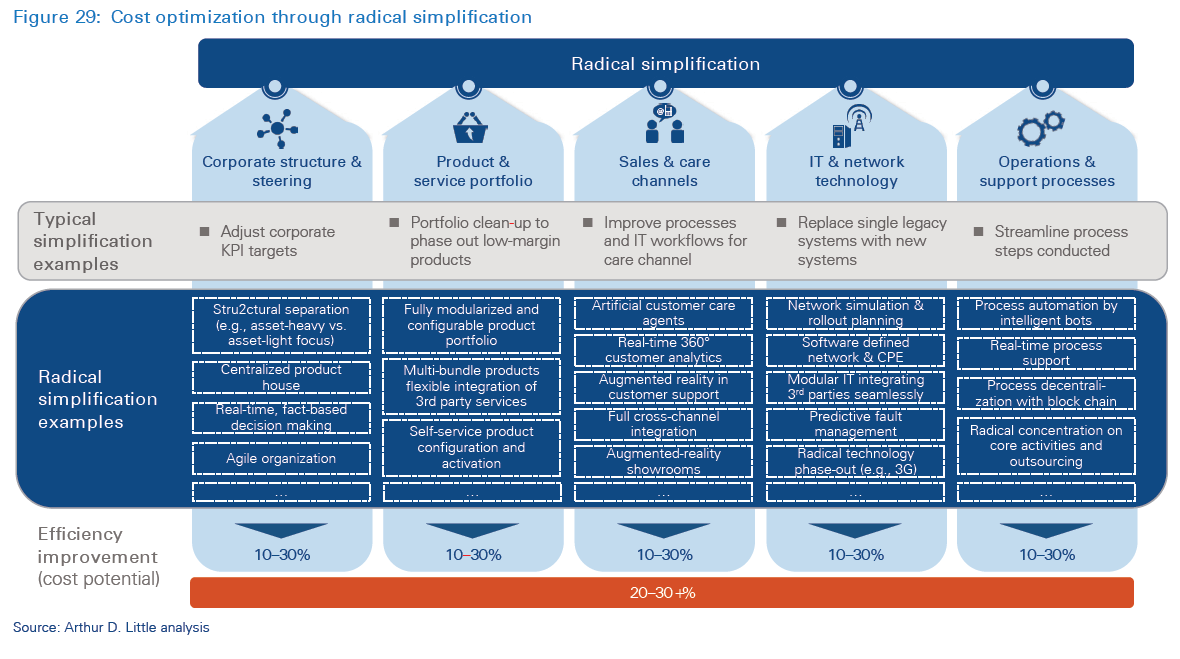
4
Preparing for the future – Inorganic options
Given the challenges faced by the telecom industry, telcos need to consider inorganic options as part of their strategies for:
- Scale of operations through in-market consolidation for improving productivity and efficiency.
- Customer lock-in through fixed-mobile convergence.
- Acquisition of new capabilities for offering value-added services, through leveraging the telco’s core platforms – for example, B2B services and cybersecurity.
- Acquisition of new capabilities for offering portfolios of services, through leveraging the customer relationship – for example, content and financial services.
Inorganic options are attractive from a strategic viewpoint, but they are hard to crack post-integration merger. The situation becomes more difficult if it requires another layer of decision making – whether to integrate the target or keep it separate.
In our global survey, 94 percent of respondents believed inorganic options could help them address the challenges. Most had used them – 85 percent indicated this. Expanding to near core was a priority for 57 percent of respondents, followed by consolidating networks (52 percent) and building digital and agile capabilities (51 percent). Approximately 40 percent of respondents anticipated engaging in inorganic options in the next 12 months.
In-market consolidation
Mergers still have a way to go
Merging operators is a traditional inorganic growth option to quickly gain market share and improve economics through solving inefficiencies or reinforcing product offerings. The situation is more acute in developing countries, where prices for voice and data services are very low, requiring operators to have sufficient market share to defray the cost of network investment over larger customer bases. A merger instantly expands coverage and can easily reinforce the telco’s position as a top-tier competitor.
In-market mergers continue to be strong. The famous merger between T-Mobile and Sprint has been in the news for many years, and has now been approved by the US Department of Justice after a long delay. Recently, Telenor and Axiata announced a non-cash merger of their telecom and infrastructure assets in Asia, in which Telenor would take a majority stake. The two entities have an overlapping footprint, and therefore expect to realize close to USD 5 billion in synergies.
In extremely competitive markets with more than four operators, there has been a trend of merging operators to improve operation viability. However, regulatory bodies do not favor markets with less than four mobile operators and impose conditions on mergers. This often ensures the entrance of a new, fourth operator, which either builds a new network or leverages competitors’ networks. This was the case in Italy, where the regulator allowed the merger of the third and fourth MNOs (H3G and Wind), but has promoted the entrance of a fourth MNO (Iliad). However, regulators should consider the EBITDA margins of telcos, as they are one of the key determinants of a telco’s level of network investment. An empirical study has shown than an operator’s investment in network is highest when its EBITDA margins are in the range of 37 percent12. If market fragmentation is high, network investment will be limited because operators have less ability to invest. Evidence shows that with the LTE experience, markets with two or three MNOs have invested higher capex than markets with four or more MNOs. Market consolidation favors the customer, as they get better quality and faster networks.
Fixed mobile convergence – A delicate value creation game
FMC has been pursued in many markets, and is gaining traction as operators offer more and more bundled products and services to lock customers in (See Figure 30). Initially, bundled products were offered to increase penetration of IPTV and internet, but with increasing market saturation, FMC-based bundled offerings now allow operators to commit customers by offering discounts. There is no impact on the overall market, but FMC is a tool for large, integrated operators to capture greater value from the market.
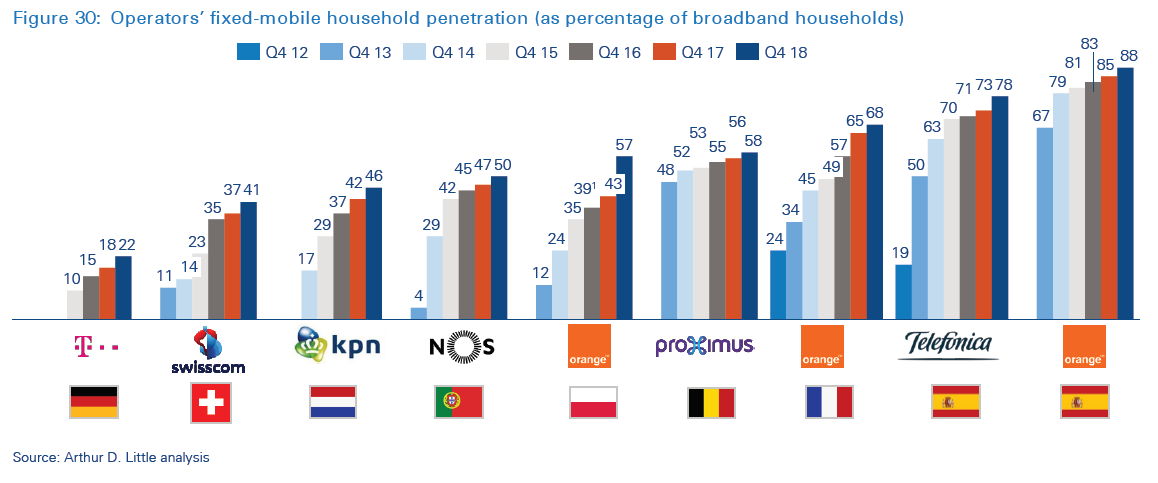
FMC cost synergies can reach several EBITDA points after three to five years, but are highly dependent on the companies being integrated. In all markets, the move to fixed-mobile bundles is rapid once initiated. In many markets, FMC-based products have very high penetration.
Launch of FMC products tends to have an immediate negative impact on mobile-only operators, which lose market share in a few quarters (See Figure 31). Fixed- or mobile-only operators finding themselves in such situations look for mergers to complement their offerings. Mergers often allow operators to rapidly attain competitive positions versus players already offering bundles. As an example, in Spain, the incumbent Telefónica had mobile and fixed networks and launched FUSION, a quadruple-play offer. This allowed it to leave the rest of the operators behind. Vodafone, which had only a mobile network, responded by acquiring ONO, a cable company with an HCF network. Orange, also a mobile-only network, acquired fixed-network operator Jazztel.
For fixed- and mobile-only operators, a move to FMC is both offensive and defensive; it usually reacts to an integrated incumbent push towards FMC. FMC was initially driven by incumbents, but now we are seeing challengers entering through M&A to pre-empt FMC market moves. In most European markets, mergers between fixed and mobile operators have already happened, and thus forced remaining mobile-only operators to look at alternate ways to leverage consolidation remedies instead of spending a fortune on M&A.
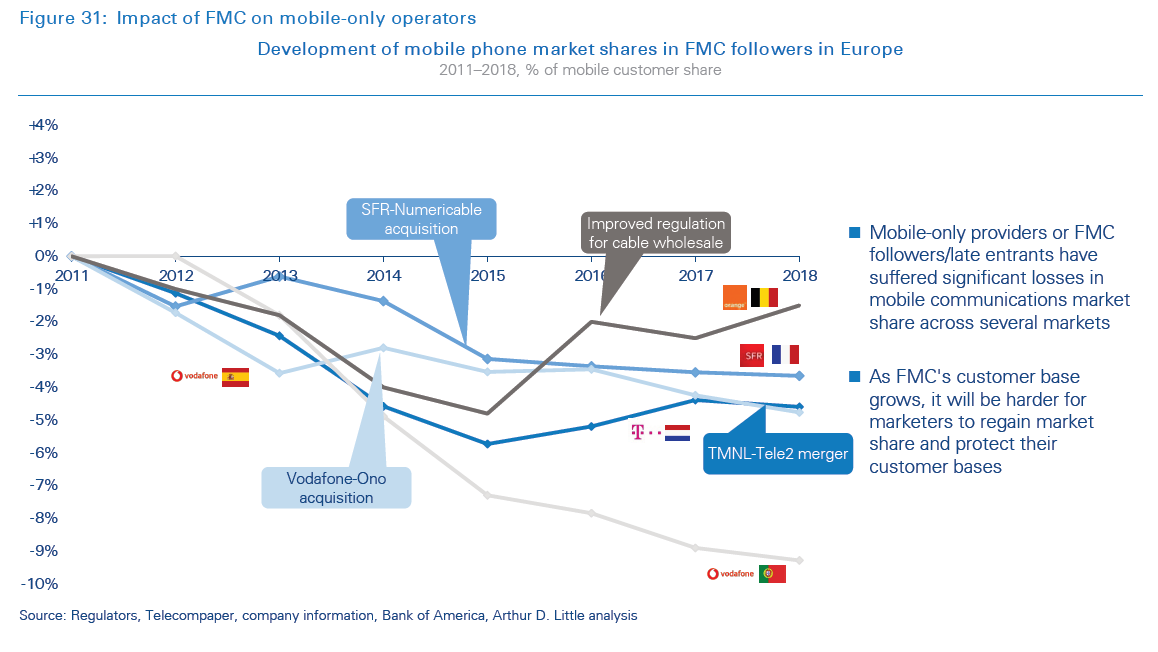
In many countries fiber is being offered wholesale through alternate networks. For example, utilities give mobile-only operators a chance to offer FMC services without making significant investments in fiber rollouts of their own. In Italy, Open Fiber, a company promoted by national utility Enel, has rolled out fiber on a wholesale basis. Initially, Telecom Italia competed with Open Fiber, but now it is considering merging its own fiber network with that of Open Fiber.
Inorganic options are necessary for B2B
Telcos have been trying to diversify their revenues beyond connectivity for many years, with some success. For example, Orange and Verizon have made significant investments in diversification, and their non-connectivity revenue contribution was around 8 percent of their revenues in 2018. This low percentage should not be viewed pessimistically, as revenues from connectivity business are extremely large, and it would take a sustained effort to reach meaningful levels. But even moderate success in new areas allows telcos the right to play in industries undergoing transformations.
As operators put significant money into 5G, it is only an upside to investing in delivering value-added services on top of connectivity. As per a GSMA13 report, the 5G and IoT opportunity for telcos lies more in enterprise than consumer. B2B opportunities are near to the core services of telecom operators. Telcos have been selling connectivity-based services to enterprise segments, but they have a chance to leverage their core capabilities to sell other value-added services to the enterprise segment. The IoT and cybersecurity are some of the few areas where telcos having invested. They have been making inorganic investments to gain expertise in industry verticals.
Will the IoT ever be big business for operators? Not if they don’t “get in”
The IoT can be a large business opportunity for telcos, but most of their IoT revenues have been less than 1 percent of their total revenue. There are a number of areas within the IoT where telcos can play:
Local or global connectivity play –Provision of IoT SIM cards and connectivity management platforms for enterprise customers. Networks include LoRa and other narrowband IoT solutions. ARPU typically ranges between 0.5 and 2 EUR per month, dropping by 5 to 15 percent each year. Connectivity revenues are a small fraction of the overall revenues generated by the IoT.
Solution play – Some operators, such as AT&T, Telstra, DT, BT, SKT, and Telia, have begun investing in a select set of vertical solutions. These include retail, venue, mining, healthcare, the city scope, etc.
Ecosystem play – The third play is aimed at providing end-toend solutions. Typically, these involve deeper collaborations with industrial technology suppliers such as ABB, Siemens, Thalis, Schlumberger, and many others. Revenues cannot be measured in SIMs or ARPU anymore, as the value capture goes beyond that. However, operators need to think carefully about which verticals to select and invest into, and how they could justify their service provisions.
However, if operators want to have meaningful stake in this area, they will have to invest in going beyond connectivity to offer solutions or develop an ecosystem. Verizon acquired drone company Skyward, as it anticipates that, in the segment of automated vehicles, the sub-segment of automated airborne vehicles, or drones, will require 5G connectivity earlier.
This seems to capture the most viable strategy for operators to take – to select the field of play, considering that connectivity and security are credible and defendable positions, and “get in”. There are many examples of operators tapping into market niches to create value for enterprise customers and capture meaningful shares of the value. Telstra, with its connected venues, is already monetizing; so are BT, with its retail solution portfolio, and Verizon, which is entering into fleet management.
Operators have to take calculated risks. Two paradigms are true for IoT investments:
- Good enough is good enough: there is no need to “boil the ocean” – as long as the opportunity is attractive (meaning there are enough customers with urgent issues to overcome and willing to pay) and reflects the operator’s go-to-market abilities, and the operator can source and deploy the required technology. That is, it does not have to be the best opportunity that is out there; it just needs to be actionable.
- Operators need to find “lighthouse” customers and scale their businesses. Without these customers pushing to collaborate on innovation, it is very hard to scale the business. Scaling the business means either attracting more customers with the same solution or offering more solutions to the same customers.
We believe the IoT opportunity is alive for operators. But we also believe it requires “getting in” to achieve more meaningful scale in terms of revenue than the current less-than-1-percent. M&A can be a suitable approach to getting access to relevant opportunities, but should follow an “innovation sourcing” investment model.
Cybersecurity – A naturally advantageous position
The do-it-yourself approach many enterprises currently deploy is not sustainable. Infrastructure, skill and workforce requirements to provide for cybersecurity simply surpass the abilities of most enterprises. As such, security-as-a-service is an increasingly relevant market segment; it is growing at double-digit CAGR that ranges from 8.7 to 17 percent.
Telcos are well positioned to engage in this segment:
- Telcos have a vested interest in ensuring that their networks and customers are protected from malicious traffic or cyberattacks. Service providers benefit from the trust customers place in them to keep them safe, and as such, they need to keep their networks up and running and available.
- Telcos have a broad view of the entire network – much more than a single customer’s access – and can thus detect threats early and comprehensively
- Telcos are really the only ones capable of fending off largescale distributed denial-of-service (DDoS) attacks due to the intensive networking infrastructure required.
- Many telcos’ brand positions are those of trusted partners.
- As they provide the networks themselves, telcos have a scale/cost advantage over third-party solutions when bundling network-based security services into their portfolios.li>
As a result, Vodafone, Deutsche Telekom, BT, AT&T, Orange, SKT, Telstra, etc., have aggregated their existing security experts into explicit units or set up security business units afresh – all of which are growing fast. Other, typically smaller, operators have yet to do so, and are still focusing on reselling/bundling thirdparty products with their connectivity services.
Orange has strengthened its position in cybersecurity by acquiring companies such as SecureData and SecureLink. Cumulative annual revenue of this business was more than €600 million in 2018. As a result, Orange is a European leader in cybersecurity, with presence in 12 European countries and a portfolio of 3,700 customers.
Overall, the number of transactions for acquisitions of securityrelated firms is growing significantly. There are two areas of concern: on one hand, the multiples of security-company acquisitions remain relatively high, with 4.1x EV/LTM revenue; but on the other hand, the required portfolios of security services are relatively broad, and each individual target is likely to perform in a relatively narrow niche.
As for provision of security services, most operators follow organic growth strategies, partially enriched with selective acquisitions. Cybersecurity is an area in which operators could be more aggressive and willing to take risks to grow faster.
The jury is still out on inorganic options for B2C
Telcos have aspired to foray into new areas, such as financial services and media content, leveraging their strong customer relationships, national presence, distribution, brand, and to some extent, digital capabilities. In diversifying into new areas, telcos lack industry-specific assets and resources. They need to combine new capabilities with existing ones to offer superior services in the market. In each area, they face competition from service providers that have scale or specializations.
Telcos must be careful where they choose to invest, as they should enhance their targets’ existing services by leveraging some of their own capabilities. It should be more than financial investment, which is something shareholders could do independently.
In the following section we see examples of telcos using inorganic options to enter media and financial services, with differing results.
In the following section we see examples of telcos using inorganic options to enter media and financial services, with differing results.
Telcos have always been interested in leveraging their customer bases and media distribution capabilities to enter the content business. They have taken inorganic routes with varying results.
Over the past two years we have been reading about AT&T’s acquisition of Time Warner, which has taken two years to approve due to antitrust appeals related to the potential for AT&T to raise costs or black out competitors’ content. This vertical merger of a content distributor and content producer is expected to bring significant synergies. Combining valuable customer data from AT&T with Time Warner’s content will enable data-informed content creation, innovative subscription and advertising models, and effective targeted advertising. With this, AT&T hopes to generate much higher advertising revenue than from traditional broadcast advertisements14. This could then be used to finance and offer content tailored to the wishes of its subscribers.
This deal is a landmark for the media industry, and it will be interesting to see whether the acquisition will help AT&T compete against Netflix, and a host of new streaming services, in a growing cord-cutting market. So far, the market is rather skeptic. Investors have lost confidence in AT&T management’s ability to handle its extraordinary debt ratio fueled by the acquisition, and grow the newly acquired entertainment business. This is because DirectTV Now, AT&T’s subsidiary which provides subscription TV streaming, lost 14 percent of its subscriber base in Q4/2018 and continues to lose more every quarter in 2019. It was also announced in March 2019 that bundles would be further slimmed down and prices would be increased. Jeff Bewkes, the CEO who sold Time Warner to AT&T, recently referred to the vertical integration of content and distribution as a “fairly suspect premise.”
In contrast, Canadian BCE (Bell Canada Enterprises) is a good example of telcos successfully venturing into the SVOD business. BCE’s Crave SVOD platform, launched in December 2014, has reached over 2.3 million subscribers. This is still lower than Netflix’s estimated 6.8 million subscribers, but after Netflix’s recent price increase, Canadians have been cancelling their subscriptions in favor of other platforms, and Crave is the top choice. BCE has taken a number of steps to help Crave become a success. It dropped the initial exclusivity for BCE TV subscribers, started investing in original content, and struck partnerships with Showtime and HBO for premium content that is currently not available on any other SVOD platform in Canada.
However, through a series of successful acquisitions – namely, of CTV in 2011 and Astral Media in 2012 – BCE has become a leading media house in Canada. Between 2008 and 2017, its share of media revenues grew from zero to 12 percent. This places BCE in a good starting position to maintain a strong foothold in the market.
Telcos planning to enter the media business by making significant investments will have to decide whether such exclusivity of content can be monetized or they should follow less risky approaches such as partnerships with content providers. For example, Singtel created joint venture HOOQ with Sony Pictures Television and Warner Bros. Established in 2015, HOOQ has been rolled out across Singtel Group’s footprint in Asia. In this partnership, the content providers offer access to their premium content and know-how, while the telco provides market access and a customer base with established billing relationships.
Financial services – Time to be brave again?
Telcos have always been attracted to the huge potential of financial services. After all, financial services is one of the major sectors to benefit from digitalization, and the telecom sector has been a key enabler. In the past, telcos have been trying to enter financial services by offering mobile payment and m-wallet solutions. As m-banking gains traction, it offers an attractive proposition for telcos. But the challenge for telcos entering into banking-related services has been lack of bankingspecific capabilities and regulatory approvals, including the need to get banking licenses. In addition, financial services is very competitive, with a large number of established players, though there is dissatisfaction among users due to the charges banks levy for maintaining accounts, and the levels of customer support provided. Internet-based companies such as Google, Apple and Facebook are also attracted to the financial services market, and have moved into payments. Amazon has entered into the SME loans business with a service called Amazon Lending. It has lent more than USD 1 billion to Amazon sellers. But so far, internet-based companies have not used their brand popularity to launch mainstream banks.
Orange France15 has taken a lead in entering banking through its acquisition of Groupama Bank, which became Orange Bank. For Orange, this move was predominantly about client retention. Orange plans to break into the traditional relationship between banks and their customers through an enhanced digital experience and better service. Orange’s entry into financial services was also facilitated by greater regulatory openness through the EU’s second Payment Services Directive (PSD2). Orange wants to leverage the combined data of phone and bank customers to offer customized services and build longterm relationships. The combined (phone) location and (bank) spending data will help the company cross-sell other products.
Orange France’s move into banking was part of a long-term plan to diversify its revenues. It had taken a lead in the rollout of fiber and 4G at the beginning of the decade. By 2018, it had established a fiber network with 12 million homes passed in France – almost 70 percent of households in the country. It had been investing in content production through Orange Studios, and subsequently, it invested in building digital capabilities and offering smart home solutions through Homelive and “Djingo”, a virtual assistant.
Orange Bank is now able to leverage its investment in Djingo to offer a new quality of customer service, as Djingo answers customers’ questions in natural language and model to perform actions such as blocking a lost bank card.
Orange indicated in its 2018 annual statement that its bank had signed up 248,00016 customers so far, and that it planned to launch in Spain in the second half of 2019, followed by Belgium, Poland and Slovakia between 2020 and 2023. It has set a target of reaching 4 million customers and €500 million of net income from banking within five years - the execution and outcome of this play still remains to be seen.
Similarly, in November 2018, T-Mobile launched a new banking service for its customers, T-Mobile Money17, which provides checking accounts for consumers with no fees and up to 4.00 percent interest – much higher than interest offered by mainstreet banks. The service is a bank-as-a-service (BaaS) solution from Customers Bancorp. All banking services are conducted through an app on a smartphone, including depositing checks, paying bills, setting up direct deposit, sending checks, transferring money, and even using mobile wallets offered by Apple, Google and Samsung. John Legere, CEO of T-Mobile, outlined the strategy in his statement: “Traditional banks aren’t mobile first, and they’re definitely not customer first. As more and more people use their smartphones to manage money, we saw an opportunity to address another customer pain point.”
Telcos’ numbers from banking services remain conservative compared to those from telecom services, and when they enter into new areas, they face competition from entrenched operators and newer attempts from Apple (card) and Google (checking accounts). However, over the long term it gives the them the right to play in these areas.
Where value is destroyed: The option space for PMI is broader than you think
The purpose of any acquisition is to increase value for the shareholder, and in the preceding paragraphs, we have debated the search areas. This is, however, not sufficient because the value can be destroyed by an unsuccessful integration.
After spending all that time and money convincing their own shareholders to move an acquisition strategy forward, and later, finding the target and persuading sell-side shareholders that the company is best sold to the acquirer, a question remains. Will the anticipated value materialize once ownership changes? Or are the soft-factor costs too expensive?
By closing time, management has put itself on the line. After all that analysis, convincing and, eventually, spending, failure to capture value from the acquisition is not an option. Indeed, this would lead to significant discontent between shareholders and executives. And we have seen many integrations fail for exactly that reason.
The answer rests in a well-designed post-merger integration strategy and execution. Let us first look at the main risks and then understand the option space:
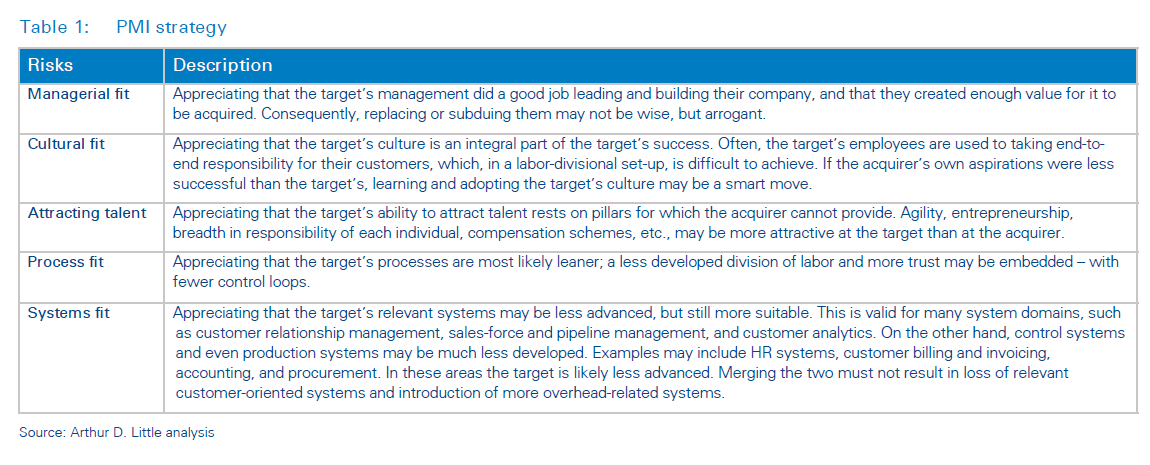
From our past work on integration, we have come across a broad spectrum of integration approaches and options, as outlined below.
There are two extreme positions: “integrate” and “keep separate”. A “keep separate” strategy is really postponing the decision. Otherwise, why was it the operator that acquired, not the shareholder? Eventually, even the consolidation reason is only meaningful if there is at least some management alignment – which essentially is the beginning of a journey towards an “integrate” strategy. But there are more options in between, which are often overlooked: “interlock” and “laissez faire” are two ways of trying to take the best of both worlds – one by design and the other emergent. It may well be that one entity is better equipped to design products and services, while the other is better equipped to entertain a broad set of channels. Alternatively, one entity could be better at marketing and sales and the other at fulfillment. Or it may be better to keep software development and presales, and integrate marketing, etc. Whatever the functional agreements, these two strategies propose that instead of trying to integrate all functions and manage across the board, it is wiser to keep certain areas of the target untouched and capture the scale benefits that come from an increase in transaction volumes.
The integration strategy is essential for any incremental value beyond financial engineering to materialize – and there are more options to choose from than may seem obvious at the start. For example, Verizon acquired XO Communications and kept it as a separate entity to offer services to its enterprise and wholesale customers.
The extreme form of these strategies is “outplace and bring back”. It implies that all functions will be managed by the target company, usually with a transformation objective. Once that objective is reached, the entire merged unit can be brought back in. The rationale for such an approach is that transforming internally is difficult, and if the target does not have enough gravity to change the established models (process environments, HR policy and salary bands, procurement policies, etc.), it may be wiser to leverage the acquisition externally, rather than trying to make it fit into an incompatible environment.
We believe shareholders and management need to develop an acquisition strategy first. This strategy needs to consider the acquirer’s own capabilities and strategic objectives, and only then search for potential available targets in the market. Overor underestimating own capabilities, lack of or compromise on strategic fit, or even opportunistic approaches often lead to trouble down the road. However, if done well, M&A can accelerate the business more than organic attempts can.
Guidelines for investment in new areas – Experiment and accept failure rather than staying on the sidelines
As telcos enter into new areas, based on empirical evidence they can increase their chances of success by following certain guidelines
- Find strength in the local market – Telcos can leverage strength in their markets because they have extensive distribution networks and understanding of their local markets; it is natural for them to leverage their strengths to enter new areas. Orange France chose to first enter banking operations in its home market before venturing into other geographies.
- Invest early – Telcos should take more risks and invest in multiple areas early in the evolution phase, as it provides more opportunities to experiment and learn about the new areas. Verizon has invested in numerous areas, from fleet management to drone management. This becomes truer as telcos move from offering horizontal connectivity services to solutions tailored to vertical industries. They need to invest in emerging companies in each vertical they have chosen to focus on. Verizon acquired a drone operations and management company, Skyward, in early 2017 as drones were coming into mainstream.
- Invest in a market leader – In areas which are beyond the nascent stage, telcos should invest in disruptive market leaders. This will help them not only capture more values, but also quickly dominate the areas. Telcos need several such deals to really impact their bottom lines. They have the scale to build meaningful synergies. In 2015, when Singtel was looking for entry in digital marketing, it acquired US-based mobile advertising solutions provider Amobee for USD 321 million. At the time of acquisition, Amobee clients included eBay, Nokia and Barnes & Noble. Singtel offered its large subscriber base in South East Asia and India to leverage the large investment in Amobee.
- Failure is acceptable – Given the fast pace of change, in which opportunities exist for only short periods and telcos are investing early in the game, a degree of failure is inevitable. The challenge is to recognize when assumptions underlying acquisition have changed for the worse and it is time to “cut your losses”. Verizon has been using M&A heavily to execute its strategy. In early 2011, it acquired Terremark, including both data centers and the private cloud business. But 2016, Verizon realized that it could not compete against specialized data center and cloud players, so it sold its data centers to Equinix and its cloud solution business to IBM.
In our global survey, more than 90 percent of respondents believed inorganic options were an essential tool for telcos to survive. But in the same survey, more than 66 percent said they would limit their capital commitments to no more 25 percent of their revenue. In comparison, internet-based companies would spend significantly more on M&A activities. Refreshingly, telcos were willing to pursue inorganic growth options, but seemed to have conservative appetites for them.
Conclusions
Inorganic options are required to transition into the future, through in-market consolidation to reach sustainable economics, divesting assets to raise cash (as addressed in Chapter 2), or planning for growth. They will have to judiciously accelerate M&A in new businesses beyond their cores – i.e., in B2C as well as in B2B2x – to prepare.
5
Building the new telecom operator:
Alignment between shareholders and management
Telcos face a multitude of challenges as the value chain is disaggregated and reconfigured. Optimistically, they have numerous options; therefore, each telco will have to choose the right one based on its circumstances and the state of the market. Building the telco of the future requires the board and management to align on the following questions:
- Where do we invest for our core business, and how fast?
- How to slice and monetize our assets so we can still manage complex operations?
- What control to keep in each divested asset, if at all?
- What future product/market should we invest in to build the next-generation telco beyond the core?li>
- In pursuing inorganic options beyond the core, how to align the interests of the shareholders, management and board.
1. Where to invest for your core business, and how fast?
The challenge for boards and CEOs of telecom operators is how to allocate capital, i.e., continue to invest into their existing businesses, invest in new areas through either organic investment or M&A, or return capital to shareholders through dividends or share buyback. This becomes more challenging because many CEOs were heads of specific functional departments and their assessments were not necessarily based on efficient capital allocation.
The next question is to how to allocate capex in the core business, as each part of the telecom value chain is critical for now and the future:
- 4G – to provide for increased coverage and capacity to meet the growing demand for data in the immediate future because 5G handsets have yet to become mass market.
- 5G – necessary to remain in the game; this will also require operators to invest in mobile edge computing.
- FTTx – operators with fixed networks will have to increase their network coverage as they begin to face competition from alternate fiber networks through utilities and, potentially, fixed wireless access through 5G.
- IT/NW – Developing IT and next-generation core networks.
- Digital transformation – Building digital capabilities to offer new services.
- In-market consolidation – Investing in M&A to consolidate the market or acquire companies to offer a new range of services.
- Brand – continue to invest in brand and communicate new products and services being launched in the market.
Capex requirements from their core businesses will, at times, exceed the budgets available for the telcos and their ability to raise additional capital. As has been the trend in many industries, unless assets are strategic and help the telco to differentiate, the “asset-light” approach is more sustainable in the long term. Because network assets are no longer differentiating for telcos, if there is a choice, they should consider investing in building capabilities which help them improve relationships with customers and bet on the future.
2. How do you slice and monetize your assets so you can still manage the complexity of your operations?
Many telcos will have to raise additional capex by monetizing their existing investments. Therefore, they will have to decide how to “slice and dice” their assets to raise the necessary funds, without losing competitiveness or unnecessarily increasing the complexity of their operations.
Another factor to consider in this exercise is how to manage the increasingly complex telco ecosystem. With multiple networks, partnerships, IT vendors, and products, as well as deeper customer relationships, the telco’s management will find it increasingly difficult to focus on differentiating across the entire value chain. Recently, in a letter18 from Elliott Management to AT&T, investors highlighted the challenges of managing such complexity: “In a world of exponentially increasing connectivity, data usage and content consumption, AT&T – despite the setbacks and issues highlighted above – remains important and valuable. With the right execution and oversight, AT&T’s businesses can generate significant value.””
A telco’s board should regularly consider its value, as a financial investor would look at “sum of the parts valuation” under a different configuration.
What control to keep in each divested asset, if at all?
The next question that arises after agreeing to monetize the assets is what level of control the telco should keep in assets that are being divested. It will also need to establish an appropriate operating model for managing or accessing the assets. These considerations help to operationalize the asset monetization strategy. The telco then has to decide on a:
- Business model – Asset sale and lease-back, form a Joint Venture, or type of partner.
- Financial model – Valuation of assets, capital structure.
- Operating model – Network deployment plan, organization structure, governance mechanism.
- Pricing – Transfer pricing model, commitment level, exclusivity, regulatory issues.
Telcos need to be clear on these parameters at the outset to avoid irreparable issues later.
Outsourcing of critical processes and assets has become commonplace in almost all major industries. Once a decision has been made to divest assets, direct financial control may not be an optimal use of cash to access the assets. Instead, the telco may decide to develop partner management capabilities that will allow it to build the appropriate service-level agreements and incentive plans. Retaining critical skills in-house to oversee such interactions would then be essential to the success of such an asset-light strategy.
3. What future product/market should you invest in to build your next-generation telco beyond the core?
A follow-on question for telcos is to where to invest cash flows generated from asset divestment beyond the core to capture growth. There are a range of options, but each has its own set of challenges. Investments have to be in areas which allow the telco to remain at the center of the value creation opportunity. Such a value creation opportunity would be diminished if it was done outside of the telco and could be indistinguishable from diversification as any other financial holding company.
The board should also consider the challenges being faced by the core business of the telco and how effectively the management has been facing up to those challenges. If there are no major attractive opportunities, the board should consider distributing the cash raised through divestment to shareholders through share buyback, as well as reducing the amount of equity that must be serviced in the long term. Reducing equity is a sensible way to align the capital structure to the changing nature of the underlying business if the decision has been made to be asset light – unless the strategy is to be an infrastructure provider.
4. In pursuing inorganic options beyond the core, how to align the interests of the shareholders, management and board?
As many of the decisions the board and management must make are very strategic, there will be decisions on which their interests and those of shareholders may not be aligned. For example, management in many situations may favor growth options with high risks, but shareholders may prefer to take money off the table by requesting dividends and share buybacks. Investing in diversification with no real synergies may lead to conflict because shareholders have the option of investing independently. These questions will naturally arise, and it is important for all involved to develop clear understanding of the objectives, criteria and overall strategy for investment in the growth of the telco. As the financial market of assets across the entire chain is a maturing, making an informed decision for stakeholders is becoming easier and more transparent.
Conclusion
The telecom industry is going through a disruptive and transformative phase in which telecom operators can pursue varied strategies. In the future, telcos will not be as homogenous as they are today. Based on the strategy it pursues, a telco will have to choose the optimal mix of assets. Telcos have some way to go to achieve operational excellence even in their core areas, but at the same time, they need to find new areas for growth. Inorganic options will play a greater role in the future strategies of telcos, as they scale up through mergers, divest assets to raise the required cash, and invest in acquiring capabilities to find growth. As the markets are evolving fast, the opportunities available today may not be in the mediumto long-term because many specialized players can quickly exploit such emerging opportunities. Therefore, telcos need to move decisively and get the execution right the first time.
DOWNLOAD THE FULL REPORT
Embracing the future
How can operators embrace telecom disruption?

DATE

Executive Summary
Introduction
The 2019 edition of our flagship report focuses on options amid disruptive times that can help telecom operators embrace the future. Telcos have been battling industry disruption for more than a decade, and today they face a confluence of innovation and investment-led threats – this requires internal reinvention, as well as a hard look at assets and whether to divest and acquire.
Our study represents a truly global view, with over 100 C-level interviews conducted between March and June 2019, and over 4,300 deals within the telecom sector analyzed. In our global survey of board members and senior executives of telecom operators, over 60 percent of respondents confirmed that the telecom sector was facing disruption. In addition, more than 90 percent of respondents suggested that inorganic options could help address the industry’s restructuring challenges and tap new value pools.
A confluence of changes – It is time to take stock
Stagnating revenues and lower margins have resulted in telcos achieving the lowest EV to EBITDA multiple compared to those for most other industries. At the same time, demand for capital expenditure is increasing because telcos have to invest in existing infrastructure not only to meet the rapid growth in data traffic, but also to find new areas for growth.
Existing revenues and margins are under threat due to both external and sector-specific factors. Some of these risks include: increasing regulatory pressure; continued substitution of over-the-top (OTT) VoIP, especially for roaming and international calls; internet protocol television (IPTV) services being taken over by subscription video on demand (SVOD); high pricing for 5G spectrum; and alternate operators offering 5G on unlicensed bands.
We expect that increasing need for capital investments will continue to place pressure on margins, especially since 5G services will not bring immediate revenue growth in the consumer space. We see operators in many countries offering 5G services at similar or even lower prices than for 4G plans.
Therefore, telcos will have to find ways to fund and build their future businesses by strengthening their core businesses and finding growth in other areas.
Reconfiguring assets – Assessing the utility of every building block in future value creation
Telcos need a new value creation approach and new capital, not only for their ongoing businesses, but also to acquire new capabilities and scale so they can grow into new areas. The disaggregation of the telecom value chain offers a new opportunity: for many telcos, networks are no longer the differentiating factor. Today, we can safely say there are pragmatic approaches they can use to unlock value from their existing asset bases.
One particular value creation has been proven – mutualization of assets, the possibility of unbundling and sharing assets. Mutualized assets are attractive to the financial community as new owners can generate better returns due to their neutrality and focused capabilities.
As we show in the report, the market for infrastructure assets is gaining depth and breadth among financial investors. If telcos do not reconfigure their value chains, other parties may step in, as disaggregated telco assets are being valued differently.
Telcos should immediately start considering opportunities to generate cash by selling off nondifferentiating assets. External vehicles will also serve to take the burden of investment off their balance sheets, which are often already stretched.
Embracing the future
Once the value chain is reconfigured, there are varied strategic options available for telcos. In the future, they will be more heterogenous. It is important that each telco defines its own strategy based on its local circumstances.
Embracing the future will require telcos to decide their target states and invest judiciously through both organic and inorganic options. Telcos are familiar with organic options, but in the face of disruption, they will also need to explore inorganic options that will achieve more defensible positions based on individual strategic choices.
Evergreen must-haves
Must-have initiatives require deep internal transformation as a key foundational element in the telecom reinvention journey. Customer experience and cost optimization are far from complete.
Telcos have to remain competitive in their traditional offerings by reinventing core networking layers and adding new network access, such as 5G/FTTX. Merging IT and network technology through a functional operating model will help in this transformation.
These efforts will not be successful if companies do not build their digital, commercial and partnership management capabilities. As they go beyond connectivity, they will need to reconsider their brands, which will have long been associated with traditional services.
Inorganic options need to be on the table
Disruption of their business models requires telcos to simultaneously scale up (e.g., in-market consolidation), monetize undervalued assets (addressed above) and bet on the future (e.g., new capabilities). Inorganic options serve the need to respond quickly to capture these fleeting opportunities.
In-market consolidation has already happened in the mobile business, but there is still some way to go. Regulators have expressed concerns over further consolidation in mobile business from four-tothree operators per market, but such concerns are misplaced. Many studies show that four-tothree-operator consolidation would help to increase investment in the telecom sector without significant impact on consumer prices. Even in the absence of regulators’ approvals, networks are already consolidating; in many markets there are only two networks.
Many M&A triggers are mobile operators in need of fixed networks to offer fixed-mobile converged services. On the other hand, the emergence of wholesale-only operators provides an option for mobile-only operators to skip the costly exercise of acquiring fixed infrastructure.
Eventually, we believe telcos will rely on M&A to grow their revenues beyond connectivity. We have seen this in media, the Internet of Things (IoT) and IT solutions.
Pursuing shareholder and board alignment to build the new telecom operator
Building the telco of the future requires shareholders to be aligned on the approach to innovating and creating additional value by acquiring new capabilities and restructuring assets.
Our discussions with CXOs revealed universal urgency to ensure that shareholders and management boards are aligned on the needs and approaches for reconfiguring telcos. Some key questions need to be addressed together by shareholders and managers together:
- Where should we invest for our core business, and how fast?
- How should we slice and monetize the assets? How should we structure the deal in terms of control, type of assets assigned to a JV, and rights to use the assets?
- What capabilities and what future product/market should we invest in to build our nextgeneration telco beyond the core, and what type of assets are to be acquired?
- In pursuing inorganic options beyond the core, how should we align the interests of the shareholders and management board? What is the best execution path towards success?
As the markets are evolving fast, the opportunities available today may not be in the medium- to long-term. Therefore, telcos must move decisively and get execution right the first time.
1
A confluence of changes – It is time to take stock
Telecom stocks have failed investors
Over the last 13 years, the telecom sector has provided low to modest returns to shareholders compared to other major industries (See Figure 1). Comparison of total returns to shareholders (TRS) for various industries between 2005 and 2018 shows a sobering picture of telecom stocks. The lack of optimism for the telecom sector is reflected in the low multiple for Enterprise Value to EBITDA compared to those of other major industries. This outcome involves stagnating revenues and continued growth in traffic volumes, coupled with high capital expenditure.
The returns from telecom stocks over the last few years have worsened (See Figure 2). They are lower than returns provided by the benchmark indices. The MSCI World Equity Index has shown significantly better returns from across industries than from global telecom operators over the last three, five and ten years, respectively.



The pessimism of the stock market toward telecom operators is well founded due to their deterioration in return on invested capital (RoIC) (See Figure 3). As a sector, telecom services show RoIC that is below the cost of capital. In the US, where the cost of capital for telecom operators is close to 6.5 percent1, operators’ RoIC is in the range of 5 percent. Telcos in Africa have a RoIC of 8 percent, but when this is adjusted for the higher sovereign risk premium of 4–5 percent, even operators in Africa’s developing markets are not able to recover their cost of capital.
Comparison of RoIC with the weighted average cost of capital (WACC) of the top 10 operators confirms the telecom industry’s worst fears – only a few operators have RoIC of more than their WACC (See Figure 4). This indicates that the issues faced by the industry are widespread and not skewed by poor performances from a few operators.
The resulting low valuation of telcos, reflected in terms low EV/ EBITDA margins, deprives telcos of access to low-cost capital, which they need for additional capital expenditure if they want to remain competitive or invest in new areas for growth. It also impedes their ability to attract top talent for transformations with stock options.


Future organic growth prospects are limited
As part of our annual assessment of the telecom industry2, we conducted an analysis on the latest available financial results from 181 telecoms operators globally, their performances since 2014, and their projected performances until 2023 (See Figure 5). The main insight from this analysis concludes:
- Telco revenues have experienced low-single-digit growth since 2014. We expect a slight uplift in revenue growth in the next five years as new use cases for 5G are rolled out, along with increased penetration for FTTx.
- Despite some revenue growth, higher capex, combined with limited opex reduction, will place pressure on free cash flow. As operators move to roll out 5G, there will be a marginal increase on capex at the same time as more and more operators are trying to outsource their network assets. This will continue to put pressure on opex.
Telcos have significant cash commitments beyond their capex: many are financially stretched because of past high capex or M&A deals that incurred significant interest and debt repayment obligations. A few telcos, especially previously state-owned incumbents, also have high dividend-payout commitments. Therefore, after considering interest, taxes, debt repayment and dividend payouts, weaker telcos have limited cash available for additional capex to improve their competitive positioning (See Figure 6).


There is no let-up in capex intensity
Capex is required for both 4G and 5G, but monetization questions remain
Mobile operators lack 5G consumer devices – Apple, Google and HMD Global (Nokia) have yet to announce 5G-enabled phones. This, combined with continued growth in data traffic, forces telcos to continue to invest in 4G capacity (See Figure 7). However, they need to commit significant capital to the upcoming investment in 5G networks. In previous technology upgrades the investments required were rather modest because the new technology was an overlay of the existing network. However, 5G will require deployment of small cell and densification.
Timotheus Höttges, CEO of Deutsche Telekom, says, “Deploying 5G across Europe could require €300 to €500 billion.” This is 1.5 to 2.5 times the total investment for 4G rollout.
According to a Morgan Stanley report3 in the US (published in February 2019), the total investment outlays/commitments towards 5G have been conservatively estimated at 35 percent, 3 https://www.morganstanley.com/ideas/5G-telecoms-share-price-drivers more than that of the total investment in 4G to date, amounting to USD 68 billion. If 70 percent of incremental capex were to depreciate over 10 years, and the balance over 20 years, to account for a non-active infrastructure upgrade, the incremental depreciation would be USD 5.78 billion per annum. Depreciation over the 250 million mobile-owning population amounts to an incremental per capita spend of USD 2, which is close to 3 percent of the existing mass market spend of USD 71. However, US ARPU has been falling over the last six years at approximately 4 percent per annum. It will be challenging for telcos to recover their incremental investments in 5G from consumers, and therefore their focus should be on developing new use cases targeted at B2B customers.
Indicated incremental ARPU requirements may not materialize, as recent launches have priced 5G services similar to those of 4G (See Figure 9). Currently, more than 50 operators have 4G mobile plans with “truly unlimited” mobile data volumes in 23 out of 41 EU28 and OECD markets. This limits the immediate upside of 5G for enhanced mobile broadband use cases. Operators can monetize 5G investments stemming from other unique use cases, such as ultra-reliable low latency communications and massive machine-type communications (e.g., augmented reality and the IoT). However, this would require wider 5G coverage and customer conversions, which would take some time.

There is a widely held perception that rapid growth of IoT devices will, in turn, drive connectivity revenue for operators. European Telecommunications Network Operators (ETNO), in its 2019 Annual Economic Report4, estimates that the number of IoT connections in Western Europe will increase from 78 million to 433 million in 2023, but IoT connectivity revenues will increase from EUR 1.5 billion in 2017 to EUR 4.1 billion in 2023.
What respondents say
During our interviews in 2019, 5G was a recurring hot topic and mentioned as the main driver for change in their core businesses. One respondent said: “The 5G battle has started with a hunt for consumers and value.” Many respondents said 5G would give them opportunities to deliver new services, enable devices from drones to hospital equipment, and foster competition in areas where FTTH was not possible. In addition, it was believed that 5G would further accelerate the adoption of IoT use cases.
However, 5G monetization remains the omnipresent concern for telecom decision makers. The path from idea and use case to business case remains bumpy.
One respondent summarized the dilemma: “Data usage will definitely increase with 5G due to new use cases, but ARPU will not. It is hard to expect people to spend much more on connectivity. Yet, we have to invest, but ‘Will these additional revenues ever make the investment returns?’ remains unclear”.
FTTx rollout is still a differentiator
Because fiber-to-the-x (FTTx) is highly valued by customers, together with the possibility to offer bundled services to B2C and additional services to B2B segments, the FTTx network is a true differentiating factor. Nevertheless, the network is developed with “blood, sweat and tears”: its capex represents at least eight times that of a mobile network.
The capex required to provide coverage per household differs across countries, depending on population density and national regulations for deployment of fiber5. Even within Europe, Sweden, Spain, and Portugal have over 90 percent FTTH, whereas countries such as France, the UK, Germany and Italy have under 50 percent. To reduce capex, regulators tend to ease entry barriers by enabling infrastructure sharing. This can be in the form of duct sharing (as in Spain), fiber in verticals (France), focused areas (a rural area in France), or even entire networks. Despite the efforts of national regulators, capex remains an uphill battle for most operators.

Investments in IT/NT modernization and digitalization still lag
The investment in 5G mentioned above does not include the capex required for network virtualization or the change of core network to decentralize network intelligence.
As stated in Arthur D. Little’s report published in 2018, “Delivering the digital dividend”, telcos typically invest 12–20 percent of their total revenue as capex, focusing it on networks, and, unlike internet-based companies, not directing it toward creating structural competitive advantage (e.g., Tesla’s Gigafactory, Apple’s retail network, Google’s global data center infrastructure and Amazon’s fulfillment centers). Telecom operators commit only fractions of their capex to digital transformation. To truly reinvent themselves as digital companies, they need to increase this capex allocation to digital initiatives and modify their investment strategies accordingly.
In addition, telcos do not tend to make smaller investments in higher-risk projects with potentially high rates of return. To truly transform into digital telcos, they will need to adapt this investment strategy and approach to a digital environment with digital risk/reward profiles.
Telcos face challenges in both existing business and diversification
Telcos face not only the challenge of slowing revenue growth and continued demand for high capex investment, but also a number of risks from within the industry and external sources (See Figure 10).

Some of the key threats from external sources include:
- The data center and cloud computing business being increasingly dominated by focused players such as Equinix and AWS.
- SVOD eating into the IPTV market – we see early signs of cord-cutting gathering momentum (at least in the US) and SVOD operators making significant investments in original content. Putting together a compelling offer takes time and investment, which will pull telcos back into the capex longhaul.
- Alternate fiber companies – many utility-based operators are choosing to offer fiber wholesale to maximize the number of homes connected as a proportion of houses passed. This could be a challenge to fixed operators planning to roll out fiber, but an opportunity for mobile-only operators that can offer fixed mobile convergence (FMC) services without having to invest.
- eSIM-based connectivity offers from internet-based companies such as Google Fi – this has been a topic of speculation for the last few years. Immediate threats from Google Fi types of services have been limited, but in the long term, telcos need to be vigilant for potential disruption.
Some of the key threats from within the industry include:
- Unlicensed 5G band – 3GPP will include 5G (NR-U6) in the unlicensed spectrum from 3GPP release 16 onwards. The NR-U network will support both the existing 5 GHz unlicensed band and the new “greenfield” 6 GHz unlicensed band. NR-U stand-alone networks in unlicensed spectrum could lead to entry of a number of local, private 5G networks dedicated to specific applications, such as industrial IoT or mobile broadband for enterprise customers. It could provide an avenue for service providers such as cable operators and ISPs, as well as neutral host service providers in public venues such as sports stadiums and malls. This could allow other service providers to offer end-to-end solutions including connectivity, and thereby potentially impact telecom operators’ revenues.
- High price for 5G spectrum – although the price of spectrum for 5G is not expected to be excessive compared to that for 3G, governments across the world have gotten used to funding the state through spectrum auctions. Spectrum auctions will remain a tool for policy makers to maximize “state” returns rather than encouraging investment in digital infrastructure. For example, Italy’s most recent 5G auction raised over EUR6.5 billion for the state.
- Continued substitution of voice international roaming by OTT VoIP – Since 2015, international voice traffic has been declining, and roaming revenues dropped after the EU implemented “Rome Like at Home”. According to a Juniper Research study7, roaming revenues are expected to stay flat over the next four years, representing around 6 percent of total operator-billed revenues and $51 billion in value.
- Internal capabilities for digital transformation – In 2018 we published a report on digitalization of the telecom industry, which highlighted how, despite the telecoms industry being a key enabler in the digital industry, most telcos considered themselves either digitally behind, or, at best, on par with other industries. The situation has not changed significantly since the report was published.
Conclusions
Telcos have been grappling with a saturating connectivity market for some time, but confluence of external and internal industry challenges will require them to take stock of their positions. With significant capex requirements, relatively lower returns, and higher cost of capital, they need to find ways to fund and build their future businesses, strengthen their core businesses, and grow in other areas. They will have to tackle multiple challenges while facing a constraint on accessing capital at attractive rates.
2
Reconfiguring assets to extract value and finance future investments
Unbundling the telco to add value for the shareholders
Telcos need to remain competitive by investing in existing infrastructure and new growth areas. The disaggregation of the telecom value chain provides an opportunity to unlock value from the company’s existing asset base. Operators need to ask the hard questions about the utility of every building block in value creation. If investments into existing and new areas are not value accretive, the board will be obliged to sell the assets and maximize the value of the firm. We have seen evidence of this with mobile towers, and are beginning to witness it with fiber. The market for telco assets has matured, and many financial investors are keen to mutualize them. Telcos are also considering new ways to slice and dice their assets to either monetize investments or reduce the capital intensity of their businesses.
Once the utility of owning the assets to meet the strategy has been determined, it is followed by a crucial step of reconfiguring the asset base to achieve the target state.
Network-wise, high broadband penetration in both mobile and fixed telecommunication services encourages a commoditization process. This further contributes to price reductions on existing products and forces players to seek differentiation in value-added services. Historically, network speed and coverage in mobile and fixed telecommunications have been at the core of battles between operators to differentiate from one another. Telcos have therefore competed to build the fastest networks with the widest-possible coverage. Consequently, in most countries there are multiple networks, which creates national inefficiencies and reduces value added for final clients, with high operator capex investments. Therefore, network consolidation of up to two to three networks is necessary for markets to benefit from competition and innovation.
As the network gap has reduced to similar coverage and capability between operators, differentiation factors must be found elsewhere. It can be argued that in consolidated markets, when end clients finds themselves with two to three operators offering the same mobile coverage and FTTH, decisions are based on price, customer experience or value-added services.
Operators have numerous opportunities to monetize their assets, including mutualizing ducts, dark fiber, mobile towers, RAN and small cells. This is made possible by new sets of investors, such as private equity, pension and infrastructure funds, which are well acquainted with the risk/return profiles of telecom infrastructure.
Owning and operating such a diverse set of infrastructures under a single telco is not only a strain on management focus, but also financially inefficient. The separation of infrastructure from the traditional business pushes each organization, the MNOs, and the network companies to focus on what they are best at. On one hand, the network company is focused on maintaining and upgrading infrastructure, improving coverage with the newest technologies, and seeking deployment efficiencies. On the other, MNOs (Retailco) still compete in the market and are able to focus on adapting their offerings to changing client needs.
Valuation impact of divergent telecom profiles
As we outlined in our 2016 report, “Major strategic choices ahead of telcos: Reconfiguring for value”, many telcos are seeing valuation decreasing year after year. Market competitiveness fueled by product commoditization is decreasing future outlook for businesses, and investors are looking at telco infrastructure. While integrated telcos are valued at 5–6 EV/EBITDA and going down, NetCos are valued at 11–17+.
Difference in valuation is mainly explained by the different risks the investor undertakes. NetCos have the vast majority of their income ensured by long-term contracts (15+ years), and thus predictable cashflows, while traditional telcos have to deal with short client contracts, churn and innovation risks. NetCos’ relative security enables them to tap into vast financing capabilities held by low-risk investors such as pension funds, infrastructure funds and private equity, which increases investor competitiveness and therefore infrastructure valuation.

Additionally, NetCos can increase their income by reselling spare fibers to competitors, as well as other types of players (such as OTT players and financial institutions). A separated NetCo increases in value for the same financial reasons as in the case of mobile towers. As an example, Chorus in New Zealand separated its network from Spark in 2008 because it had won most of the government’s fiber deployments, aiming to become a national network wholesaler, and the government had imposed the separation. Initially, its shares traded as low as 4–5x EBITDA, but have since grown to 8x EBITDA due to a clearer regulatory backdrop emerging.
Reconfiguring assets: Options for shareholders
Disaggregation of the value chain creates divergence in valuations of different asset classes (See blue box page 19: “Valuation impact of divergent telecom profiles”), as many telco assets are used more efficiently through increased sharing in the hands of new owners. Therefore, boards will find restructuring of telcos increasingly important. External investors, such as hedge funds, will be tempted to invest in telecom operators to unlock the value of the assets they hold.
As segregation of the telco value chain is better understood in the market, private equity/investment firms see arbitrage value by hiving off the different assets of the telco into separate companies, where the value of individual parts is more than that of an integrated telco. Elliott Management, a hedge fund, launched a bid for Telecom Italia in 2018. Elliott detailed the reason for the separation of Telecom Italia, which was based on segregating its assets into different entities (See Figure 12).


Reconfiguring key telco assets – Towers and fiber
The boards of many telecom operators have been reconfiguring assets by separating off mobile towers, as well as fiber assets in specific cases.
As many mobile networks have similar footprints, the synergies ,from tower consolidation are obvious. Therefore, there has been rapid growth in the mobile network consolidation market in the last few years. Whereas only 28 percent of European sites were owned by TowerCos in 2011, by 2018, 47 percent of all mobile sites were carved out from MNOs to become either captive or independent TowerCos (See Figure 13). The US and India are leading this trend.
Tower companies are providing higher returns than telecom operators are, as efficiency increases and long-term cash flows are ensured when assets are shared among operators (See Figure 14).
As more and more operators relook at the infrastructure arena, they are widening the infrastructure market by tapping into sunken assets to improve their performances. Although global markets are at different maturity levels, they are all increasingly looking at passive and active assets as actionable levers. When comparing infrastructures, mobile networks stand at the forefront of market development. This is because competitors have reached similar coverage earlier, which has reduced their network differentiation value.


The FTTx network is likely to be the next network asset to be mutualized as it is underutilised with relatively low levels of subscriptions of the homes passed (See Figure 15). Similar to with mobile towers, the high value of fiber assets, along with certainty of cash flows, is leading to an increase in transaction prices for such assets and creating large financing options for operators. Additionally, a NetCo can increase its income by reselling spare fibers to competitors and other types of players (such as OTT players and financial institutions).
As fiber wholesale models become increasingly prevalent, investors are now attracted to financing fiber rollout from the inception stage. Telcos are also becoming more sophisticated in their involvement of infrastructure funds, offering different parts of their fiber networks to specific types of investors. In these cases the cash flows and risk/return profiles of the businesses match those of the profiles of the investors. Now, fiber networks are being apportioned into fiber-to-the-antenna (FTTA), fiber-tothe-office (FTTO), metro fiber and fiber in the core networks (See Figure 17). These deals are becoming more and more common – in 2018, TelePacific in the US sold and leased back metro fiber to Uniti Group, a telecom real estate investment trust. Altice France has sold a 49.99 percent minority stake in fiber-optic business SFR FTTH for $2.05 billion to Allianz, AXA and Omers Infrastructure.


A similar opportunity exists in offering 5G capacity to specific customers using network slicing. Telcos can form joint ventures with organizations which would normally roll out their own dedicated networks (e.g., utilities and government agencies). With these deals, telcos can also use the organizations’ spectrum and, in return, offer dedicated capacity (See Figure 18). This type of an arrangement is mutually beneficial, as the telecom operator gets access to spectrum and steady cash flows, and the government agency gets a state-of-the-art telecom network with very low maintenance overheads. It is also acceptable to regulators because it leads to more efficient use of spectrum.

Case study – Cellnex Telecom: A success case
Cellnex Telecom (formerly Abertis Telecom) has consolidated as Europe’s largest TowerCo, with a solid track record of M&A across the continent. The company has evolved through inorganic growth, from a local, mono-product Spanish company offering broadcast services, to a multinational group with a diversified product portfolio.

On the buyer side, Cellnex has acquired assets from major European operators:
- In Italy, from Iliad and H3G, which then merged with Wind to form the third-largest operator in the country.
- In France, from Bouygues Telecom and Free, which has allowed the independent TowerCo to consolidate national networks.
- In Switzerland, from Sunrise and Salt, which has given it the opportunity to consolidate networks.
- In Spain, from Telefónica and Masmovil.
Cellnex has become a lighthouse for infrastructure acquisition due to its European expansion. In four years the company has reached European presence in six countries, and its market value has increased at each acquisition. While its price per share has increased from EUR15 to EUR27 between 2015 and 2019, its market capitalization has rocketed from EUR3.994 million to EUR8.658 million in the same period.

Conclusions
Telcos can take advantage of the disaggregation of the value chain to mutualize their assets. Mutualization of assets creates an opportunity for telecom players to monetize their investments as financial investors find them attractive. In recent years, the market for telecom infrastructure assets has gained in both depth and breadth among investors. Telcos should consider this opportunity to generate the necessary cash flows to invest in their core and future businesses by spinning off non-differentiating assets. If they do not move to efficiently use assets that are commensurate with their business models, infrastructure funds and private equities will look to disaggregate them. The key challenge for telcos is to decide the types of assets they want to hive off and, at the same, avoid losing control over the use of such assets.
3
Embracing the future: Must-haves to complete the unfinished agenda
Telcos of the future will be more heterogenous
Telcos of the future will have to not only tackle disruptions of their value chains, but also identify areas in which to compete and differentiate in the disaggregated value chain of infrastructure, platform and services layers (See Figure 21).
Each layer offers its own set of challenges and opportunities. As there are varied possibilities across the different layers, the telcos of the future will be significantly more heterogenous than they are today. In the future, operators could be simple, efficient, network-based connectivity/infrastructure providers, or they could be diversified players offering a range of services, such as banking, media and IT solutions, in addition to connectivity.

Infrastructure layer: Reconfiguring the infrastructure
- Provisioning of connectivity services is increasingly converging at the network level, and softwarization of networks across multiple layers is triggering a need for examining stand-alone plays.
Platform layer: Developing platforms that drive agility and digitalization:
- Digitalizing and adopting newer production/operations architectures are a hygiene factor to stay “in the game”. Operators can build on such capabilities to offer tailor-made solutions (e.g., industry-specific IoT solutions).
Services layer: Battling for customer relationships:
- The battle for customer relationships in saturated communications markets drives the need to deepen the relationship by providing convergent bundles, value-added services, and branching out into altogether new territories in terms of customer relationships (e.g., banks).
- This, in turn, drives the need for not only the platforms needed to serve customers, but also the underlying people capabilities that can deliver this aspiration.
- Even within the same customer relationship, new business models have to address emerging customer needs with effective monetization, which may include working with the broader ecosystem to target the same customers.
Depending on its strategy, a telco could focus on only one layer or a sliver of layers to develop a defendable position.
- “Bitpipe” – A broad cost leader: An operational- and capital efficiency-focused connectivity player with efficient cost leadership, which succeeds by serving a broader market. Examples include pure service players with lean assets that already have or are achieving scale plays.
- “Niche” – Focused cost leadership and differentiation: Operations that focus on customer segments anywhere within the value chain. Examples include spectrum holders, virtual operators and passive infrastructure players.
- “Global/regional ICT plays” – Differentiated: A differentiated ICT player with varying degrees of service-level diversification, which uses scale possibilities in every target market/segment.
- “Diversified” – Differentiated with deeper customer relationships: A player aiming for success by being present in multiple industries, aided by deep customer relationships and betting on cross-industry diversification opportunities.
Transitioning from existing connectivity-based focus to the desired state requires a telco to define its target state based on its local circumstances, and then execute the unfinished agenda and pursue inorganic approaches to find growth (See Figure 22).
Must-haves - Innovate the core and complete the unfinished agenda
In our review of the strategies of the top 10 telecom operators in their 2018 annual reports, the top three priorities for telcos related to organic options (See Figure 23). Telcos must remain competitive in their core offerings by investing in 5G/FTTX, IT/ network technology, and brand. At the same time, they need to build capabilities required for the future, which include being digitally enabled, commercial excellence, and partnership management capabilities. In addition, customer experience and cost optimization are far from being completed.



Investing in 5G and FTTx is a necessity
There may be uncertainties about the economic viability of 5G rollout, but on the ground 5G is fast becoming a reality across the globe. It is an inevitable industry race for operators to follow, or they will risk losing key customers (See Figure 24). Waiting too long to deploy 5G can make operators miss out early adopters and lose customers from their own bases.
As stated in our report, “The race to 5G”8,8 although many countries have started to deploy 5G networks, only a few are focusing on the traditional mobile mass market (consumers) to enhance user experience. Overall, we see the three deployment models – gigabit broadband to the home, industrial digitalization through corporate networks, and digital industrial use cases – as the key uses triggering most 5G network advancements. Since in these use cases customers are located beyond central business districts, telcos will be required to roll out 5G networks to remote areas. This will require significant investments.
As mentioned above, many countries lag in FTTx rollout because they have good-quality cable networks, or incumbents that are slow to introduce fiber because they want to maximize returns from their existing copper networks. Some countries that have low fiber penetration risk entry of wholesale-only providers. A report by Barclays (See Figure 25) states that Germany and the UK have the most potential (risk for incumbents) for entry of alternate wholesale operators (similar to Open Fiber in Italy). Open Fiber has been rapidly increasing its market share through a wholesale model. Therefore, fixed operators will have to decide to accelerate their investments in FTTx or risk being left behind by this model.


Reinvent the IT/NT
The ability to scale out services will gain importance as operators transform their production models to reach beyond their network footprints. We anticipate dynamics occurring in three ways:
- Operators managing other carriers’ networks in noncompeting territories.
- Operators integrating with other networks to address the needs of multinational customers beyond their own network footprints.
- Operators allowing other carriers to use their own networks, with less manual intervention in the process.
We continue to envision a world in which operators compete in markets well beyond their own network assets and reach, but still utilize their operational support system (OSS) and business support system (BSS) platforms. The network operator’s competitive environment will change: web-like collaboration possibilities will drive competition on a global scale and, as such, may drive further consolidation. This will require telcos to restructure their IT and network technologies (See Figure 26).
As networks are increasingly virtualized, their design and development activities start to resemble application development within their IT organizations, even though the required skills and competencies continue to differ to some extent. Operators need to change their approaches to organization design in order to address these converging functional requirements. We see the technology organizations of telcos transitioning9 from the current (and often independent) structure of network and IT verticals, to infrastructure and application layers. This will possibly be followed by highly integrated technology organizations.
Reinvent the brand
As per Brand Finance109, the five most valuable brands are Amazon, Apple, Google, Microsoft and Samsung. AT&T and Verizon are in the top 10 and have increased their value by an average of 8 percent over previous year. However, other large telcos have not performed well; both China Mobile and Deutsche Telecom fell by three places in their rankings in 2019. NTT fell by nine more places. There is a challenge for telcos, as they are perceived as utilities offering only connectivity services. As telcos enter new areas, they will have to spend considerable effort and resources to rebrand themselves as more than utilities and show that they offer a range of services.

Telco rebranding has multiple aspects to it. It is more than just rebranding the company’s main logos. As telcos offer increased ranges of service and target specific customer segments, they need to consider multiple-brand strategies, which require all marketing and product offerings to be aligned. A few telcos are in the process of launching sub-brands. For example, Vodafone launched Voxi, a SIM-only brand. Similarly, the Vodafone enterprise was recently rebranded as Vodafone Business. The enterprise previously had no external logo. Iris Meijer, chief marketer of Vodafone Business, commented10: “Customer centricity is a concept that has stood the test of time. When we began to explore the idea of our brand refresh, reaching out to our customers from the home office to the boardroom, each was worried about the same thing: digital transformation. We have known for some time that our customers want a partner to join them on their digital journey, a partner they can trust.”
Build future capabilities to make telcos sustainable
Digital transformation and customer experience are crucial for both survival and growth
Digital transformation opportunities exist across the telco business model. Globally, major fixed and mobile operators have engaged in digital transformation, embedding digital initiatives at various maturity stages within different parts of their businesses. The results of our survey show this disparity of digital maturity. They also indicate that despite being key enablers in the digital industry, telcos consider themselves at the beginning of the digital transformation journey.
Even in diversification, telcos’ core capabilities matter – probably even more than usual because diversification should never be an arbitrary move. The key challenge remains integrating “different market” businesses into the existing portfolio to create a sustainable and defendable whole business. Telcos need to leverage digital capabilities they have developed for their own core business processes, and build upon them to move into new industry verticals. Once they have developed superior services, this can be productized and adapted to different geographies and client segments.
Telcos have long realized the strategic importance of customer experience, yet translating this strategy into action and tangible experience for customers is long overdue. Telcos face increasing competition from in-market players, as well as OTT players with digital-first approaches enabled by software capabilities, new-age skills and customer-obsessed mind-sets. In such a hyper-competitive context, customer experience is arguably the most fundamental lever for telcos’ survival. However, the challenge is ever-increasing customer expectations, driven by customers’ exposure to a range of digital-native services across ecosystems. This exposure makes the difference between the experience delivered by digital-native players, and that from telcos, extremely striking.
For example, today’s customers enjoy the option of configuring and customizing their purchases in line with their needs via digital channels (e.g., staple service configuration), but they have to pick and choose from preset mobile data bundles or tariff plans. They can expect their food orders be fulfilled in less than 60 minutes (delivery promised by Deliveroo), but they must wait for days for their sim cards to be delivered. They enjoy real-time transparency on product/service orders (e.g., Uber), but not when it comes to home broadband service installations and activations. They enjoy extreme responsiveness in complaint/service failure resolution (e.g., Royal Bank of Scotland predicts and resolves customer issues before they are even raised), but are promised three working days to have their telecom service disruptions resolved. In summary, telcos must seek inspiration from players operating beyond traditional industry boundaries, as their customers’ expectations are fueled and shaped by new benchmarks in customer centricity.

Our global benchmark indicates that a typical telecom operator’s customer raises more than twice the number of complaints as the industry best-in-class (See Figure 28). Telcos should use digital transformation to continuously reduce the volume of complaint incidences and radically improve the speed of complaint redressal.
Commercial excellence needed to find opportunities of the future
Telcos must continue to invest in their infrastructure and develop digital capabilities, but to monetize such investments they will also have to build commercial skills to help them identify, and develop, new opportunities. Telcos currently lack expertise in this area, as they are used to having defined products and services that are inherent to their infrastructure. They need to develop the ability to identify new opportunities, especially in commercial areas, to build new business models and put themselves at the heart of the value chain. Telcos should be able to combine their capabilities with those of other players to develop innovative business models and solutions.
For example, Swisscom Energy Solutions’ tiko11, a joint venture between Swisscom and Repower, connects energy users and smart storage networks with electricity grids. It also responds effectively to rapid changes in demand and acts as a virtual power plant (balancing energy). In the process, it passes savings to users who are willing to connect their devices to the smart grid solution.
The venture was developed from existing solutions in both the telecommunication and energy sectors. It required only six months to develop a first version of software and hardware to connect the first residential customers’ heating systems. Since then, tiko has continuously innovated to develop new solutions. It can be easily leveraged to offer IoT services, and therefore has huge potential.
In essence, telcos will have to think innovatively to develop solutions that will leverage their current strengths and form a new ecosystem in which they will be in control.
Partner management is crucial for an increasingly complex ecosystem
As telcos reconfigure their networks and offer a range of services with fat tails, they will need to develop strong partnership management capabilities. Currently, they have complete control over their value chains, and only a few parts of the value chain have been outsourced. But in the future, they will be operating diverse sets of networks with very different business models. As operators become asset light, they will increase procurement of multiple networks as services. This will reduce operating costs through outsourcing processes and delivery of multiple services to consumers as “business-tobusiness-to-x” (B2B2x), or directly to consumers through ranges of partners. All of this will require telcos to develop excellent partner management capabilities. They will need to have flexible approaches that allow them to quickly enter markets with opportunities, and be ready to exit if those opportunities don’t materialize.
Cost optimization – The ongoing challenge
Cost optimization is a must-have in any industry, especially mature industries. Over the years, telcos have amassed complexities in their services, technologies and operational portfolios, and these are major drivers for increased costs. Conventional one-off cost-cutting initiatives are not sufficient to deliver potential benefits. Telcos can gain 20–30 percent efficiency by addressing the complexities in their businesses (See Figure 29). They should consider transforming their operations to:
- Radically simplify services, technologies and operations portfolios.
- Adopt suitable network asset management models.
- Rethink their sourcing/contracting models across customer, IT and network operations.
- Exploit technology and infrastructure virtualization opportunities.
- Digitalize operational processes.
- Transform towards lean and agile organization structures.
Conclusions
Even though revenue may be stagnating in the connectivity business, telcos must manage the transition into a new ecosystem. This will require them to judiciously invest in existing infrastructure to remain competitive, as well as in developing new capabilities for future business. The transition is not easy, and with varied options available, telco boards and management must decide on the future states of their businesses based on their respective risk-and-return appetites.

4
Preparing for the future – Inorganic options
Given the challenges faced by the telecom industry, telcos need to consider inorganic options as part of their strategies for:
- Scale of operations through in-market consolidation for improving productivity and efficiency.
- Customer lock-in through fixed-mobile convergence.
- Acquisition of new capabilities for offering value-added services, through leveraging the telco’s core platforms – for example, B2B services and cybersecurity.
- Acquisition of new capabilities for offering portfolios of services, through leveraging the customer relationship – for example, content and financial services.
Inorganic options are attractive from a strategic viewpoint, but they are hard to crack post-integration merger. The situation becomes more difficult if it requires another layer of decision making – whether to integrate the target or keep it separate.
In our global survey, 94 percent of respondents believed inorganic options could help them address the challenges. Most had used them – 85 percent indicated this. Expanding to near core was a priority for 57 percent of respondents, followed by consolidating networks (52 percent) and building digital and agile capabilities (51 percent). Approximately 40 percent of respondents anticipated engaging in inorganic options in the next 12 months.
In-market consolidation
Mergers still have a way to go
Merging operators is a traditional inorganic growth option to quickly gain market share and improve economics through solving inefficiencies or reinforcing product offerings. The situation is more acute in developing countries, where prices for voice and data services are very low, requiring operators to have sufficient market share to defray the cost of network investment over larger customer bases. A merger instantly expands coverage and can easily reinforce the telco’s position as a top-tier competitor.
In-market mergers continue to be strong. The famous merger between T-Mobile and Sprint has been in the news for many years, and has now been approved by the US Department of Justice after a long delay. Recently, Telenor and Axiata announced a non-cash merger of their telecom and infrastructure assets in Asia, in which Telenor would take a majority stake. The two entities have an overlapping footprint, and therefore expect to realize close to USD 5 billion in synergies.
In extremely competitive markets with more than four operators, there has been a trend of merging operators to improve operation viability. However, regulatory bodies do not favor markets with less than four mobile operators and impose conditions on mergers. This often ensures the entrance of a new, fourth operator, which either builds a new network or leverages competitors’ networks. This was the case in Italy, where the regulator allowed the merger of the third and fourth MNOs (H3G and Wind), but has promoted the entrance of a fourth MNO (Iliad). However, regulators should consider the EBITDA margins of telcos, as they are one of the key determinants of a telco’s level of network investment. An empirical study has shown than an operator’s investment in network is highest when its EBITDA margins are in the range of 37 percent12. If market fragmentation is high, network investment will be limited because operators have less ability to invest. Evidence shows that with the LTE experience, markets with two or three MNOs have invested higher capex than markets with four or more MNOs. Market consolidation favors the customer, as they get better quality and faster networks.
Fixed mobile convergence – A delicate value creation game
FMC has been pursued in many markets, and is gaining traction as operators offer more and more bundled products and services to lock customers in (See Figure 30). Initially, bundled products were offered to increase penetration of IPTV and internet, but with increasing market saturation, FMC-based bundled offerings now allow operators to commit customers by offering discounts. There is no impact on the overall market, but FMC is a tool for large, integrated operators to capture greater value from the market.

FMC cost synergies can reach several EBITDA points after three to five years, but are highly dependent on the companies being integrated. In all markets, the move to fixed-mobile bundles is rapid once initiated. In many markets, FMC-based products have very high penetration.
Launch of FMC products tends to have an immediate negative impact on mobile-only operators, which lose market share in a few quarters (See Figure 31). Fixed- or mobile-only operators finding themselves in such situations look for mergers to complement their offerings. Mergers often allow operators to rapidly attain competitive positions versus players already offering bundles. As an example, in Spain, the incumbent Telefónica had mobile and fixed networks and launched FUSION, a quadruple-play offer. This allowed it to leave the rest of the operators behind. Vodafone, which had only a mobile network, responded by acquiring ONO, a cable company with an HCF network. Orange, also a mobile-only network, acquired fixed-network operator Jazztel.
For fixed- and mobile-only operators, a move to FMC is both offensive and defensive; it usually reacts to an integrated incumbent push towards FMC. FMC was initially driven by incumbents, but now we are seeing challengers entering through M&A to pre-empt FMC market moves. In most European markets, mergers between fixed and mobile operators have already happened, and thus forced remaining mobile-only operators to look at alternate ways to leverage consolidation remedies instead of spending a fortune on M&A.

In many countries fiber is being offered wholesale through alternate networks. For example, utilities give mobile-only operators a chance to offer FMC services without making significant investments in fiber rollouts of their own. In Italy, Open Fiber, a company promoted by national utility Enel, has rolled out fiber on a wholesale basis. Initially, Telecom Italia competed with Open Fiber, but now it is considering merging its own fiber network with that of Open Fiber.
Inorganic options are necessary for B2B
Telcos have been trying to diversify their revenues beyond connectivity for many years, with some success. For example, Orange and Verizon have made significant investments in diversification, and their non-connectivity revenue contribution was around 8 percent of their revenues in 2018. This low percentage should not be viewed pessimistically, as revenues from connectivity business are extremely large, and it would take a sustained effort to reach meaningful levels. But even moderate success in new areas allows telcos the right to play in industries undergoing transformations.
As operators put significant money into 5G, it is only an upside to investing in delivering value-added services on top of connectivity. As per a GSMA13 report, the 5G and IoT opportunity for telcos lies more in enterprise than consumer. B2B opportunities are near to the core services of telecom operators. Telcos have been selling connectivity-based services to enterprise segments, but they have a chance to leverage their core capabilities to sell other value-added services to the enterprise segment. The IoT and cybersecurity are some of the few areas where telcos having invested. They have been making inorganic investments to gain expertise in industry verticals.
Will the IoT ever be big business for operators? Not if they don’t “get in”
The IoT can be a large business opportunity for telcos, but most of their IoT revenues have been less than 1 percent of their total revenue. There are a number of areas within the IoT where telcos can play:
Local or global connectivity play –Provision of IoT SIM cards and connectivity management platforms for enterprise customers. Networks include LoRa and other narrowband IoT solutions. ARPU typically ranges between 0.5 and 2 EUR per month, dropping by 5 to 15 percent each year. Connectivity revenues are a small fraction of the overall revenues generated by the IoT.
Solution play – Some operators, such as AT&T, Telstra, DT, BT, SKT, and Telia, have begun investing in a select set of vertical solutions. These include retail, venue, mining, healthcare, the city scope, etc.
Ecosystem play – The third play is aimed at providing end-toend solutions. Typically, these involve deeper collaborations with industrial technology suppliers such as ABB, Siemens, Thalis, Schlumberger, and many others. Revenues cannot be measured in SIMs or ARPU anymore, as the value capture goes beyond that. However, operators need to think carefully about which verticals to select and invest into, and how they could justify their service provisions.
However, if operators want to have meaningful stake in this area, they will have to invest in going beyond connectivity to offer solutions or develop an ecosystem. Verizon acquired drone company Skyward, as it anticipates that, in the segment of automated vehicles, the sub-segment of automated airborne vehicles, or drones, will require 5G connectivity earlier.
This seems to capture the most viable strategy for operators to take – to select the field of play, considering that connectivity and security are credible and defendable positions, and “get in”. There are many examples of operators tapping into market niches to create value for enterprise customers and capture meaningful shares of the value. Telstra, with its connected venues, is already monetizing; so are BT, with its retail solution portfolio, and Verizon, which is entering into fleet management.
Operators have to take calculated risks. Two paradigms are true for IoT investments:
- Good enough is good enough: there is no need to “boil the ocean” – as long as the opportunity is attractive (meaning there are enough customers with urgent issues to overcome and willing to pay) and reflects the operator’s go-to-market abilities, and the operator can source and deploy the required technology. That is, it does not have to be the best opportunity that is out there; it just needs to be actionable.
- Operators need to find “lighthouse” customers and scale their businesses. Without these customers pushing to collaborate on innovation, it is very hard to scale the business. Scaling the business means either attracting more customers with the same solution or offering more solutions to the same customers.
We believe the IoT opportunity is alive for operators. But we also believe it requires “getting in” to achieve more meaningful scale in terms of revenue than the current less-than-1-percent. M&A can be a suitable approach to getting access to relevant opportunities, but should follow an “innovation sourcing” investment model.
Cybersecurity – A naturally advantageous position
The do-it-yourself approach many enterprises currently deploy is not sustainable. Infrastructure, skill and workforce requirements to provide for cybersecurity simply surpass the abilities of most enterprises. As such, security-as-a-service is an increasingly relevant market segment; it is growing at double-digit CAGR that ranges from 8.7 to 17 percent.
Telcos are well positioned to engage in this segment:
- Telcos have a vested interest in ensuring that their networks and customers are protected from malicious traffic or cyberattacks. Service providers benefit from the trust customers place in them to keep them safe, and as such, they need to keep their networks up and running and available.
- Telcos have a broad view of the entire network – much more than a single customer’s access – and can thus detect threats early and comprehensively
- Telcos are really the only ones capable of fending off largescale distributed denial-of-service (DDoS) attacks due to the intensive networking infrastructure required.
- Many telcos’ brand positions are those of trusted partners.
- As they provide the networks themselves, telcos have a scale/cost advantage over third-party solutions when bundling network-based security services into their portfolios.li>
As a result, Vodafone, Deutsche Telekom, BT, AT&T, Orange, SKT, Telstra, etc., have aggregated their existing security experts into explicit units or set up security business units afresh – all of which are growing fast. Other, typically smaller, operators have yet to do so, and are still focusing on reselling/bundling thirdparty products with their connectivity services.
Orange has strengthened its position in cybersecurity by acquiring companies such as SecureData and SecureLink. Cumulative annual revenue of this business was more than €600 million in 2018. As a result, Orange is a European leader in cybersecurity, with presence in 12 European countries and a portfolio of 3,700 customers.
Overall, the number of transactions for acquisitions of securityrelated firms is growing significantly. There are two areas of concern: on one hand, the multiples of security-company acquisitions remain relatively high, with 4.1x EV/LTM revenue; but on the other hand, the required portfolios of security services are relatively broad, and each individual target is likely to perform in a relatively narrow niche.
As for provision of security services, most operators follow organic growth strategies, partially enriched with selective acquisitions. Cybersecurity is an area in which operators could be more aggressive and willing to take risks to grow faster.
The jury is still out on inorganic options for B2C
Telcos have aspired to foray into new areas, such as financial services and media content, leveraging their strong customer relationships, national presence, distribution, brand, and to some extent, digital capabilities. In diversifying into new areas, telcos lack industry-specific assets and resources. They need to combine new capabilities with existing ones to offer superior services in the market. In each area, they face competition from service providers that have scale or specializations.
Telcos must be careful where they choose to invest, as they should enhance their targets’ existing services by leveraging some of their own capabilities. It should be more than financial investment, which is something shareholders could do independently.
In the following section we see examples of telcos using inorganic options to enter media and financial services, with differing results.
In the following section we see examples of telcos using inorganic options to enter media and financial services, with differing results.
Telcos have always been interested in leveraging their customer bases and media distribution capabilities to enter the content business. They have taken inorganic routes with varying results.
Over the past two years we have been reading about AT&T’s acquisition of Time Warner, which has taken two years to approve due to antitrust appeals related to the potential for AT&T to raise costs or black out competitors’ content. This vertical merger of a content distributor and content producer is expected to bring significant synergies. Combining valuable customer data from AT&T with Time Warner’s content will enable data-informed content creation, innovative subscription and advertising models, and effective targeted advertising. With this, AT&T hopes to generate much higher advertising revenue than from traditional broadcast advertisements14. This could then be used to finance and offer content tailored to the wishes of its subscribers.
This deal is a landmark for the media industry, and it will be interesting to see whether the acquisition will help AT&T compete against Netflix, and a host of new streaming services, in a growing cord-cutting market. So far, the market is rather skeptic. Investors have lost confidence in AT&T management’s ability to handle its extraordinary debt ratio fueled by the acquisition, and grow the newly acquired entertainment business. This is because DirectTV Now, AT&T’s subsidiary which provides subscription TV streaming, lost 14 percent of its subscriber base in Q4/2018 and continues to lose more every quarter in 2019. It was also announced in March 2019 that bundles would be further slimmed down and prices would be increased. Jeff Bewkes, the CEO who sold Time Warner to AT&T, recently referred to the vertical integration of content and distribution as a “fairly suspect premise.”
In contrast, Canadian BCE (Bell Canada Enterprises) is a good example of telcos successfully venturing into the SVOD business. BCE’s Crave SVOD platform, launched in December 2014, has reached over 2.3 million subscribers. This is still lower than Netflix’s estimated 6.8 million subscribers, but after Netflix’s recent price increase, Canadians have been cancelling their subscriptions in favor of other platforms, and Crave is the top choice. BCE has taken a number of steps to help Crave become a success. It dropped the initial exclusivity for BCE TV subscribers, started investing in original content, and struck partnerships with Showtime and HBO for premium content that is currently not available on any other SVOD platform in Canada.
However, through a series of successful acquisitions – namely, of CTV in 2011 and Astral Media in 2012 – BCE has become a leading media house in Canada. Between 2008 and 2017, its share of media revenues grew from zero to 12 percent. This places BCE in a good starting position to maintain a strong foothold in the market.
Telcos planning to enter the media business by making significant investments will have to decide whether such exclusivity of content can be monetized or they should follow less risky approaches such as partnerships with content providers. For example, Singtel created joint venture HOOQ with Sony Pictures Television and Warner Bros. Established in 2015, HOOQ has been rolled out across Singtel Group’s footprint in Asia. In this partnership, the content providers offer access to their premium content and know-how, while the telco provides market access and a customer base with established billing relationships.
Financial services – Time to be brave again?
Telcos have always been attracted to the huge potential of financial services. After all, financial services is one of the major sectors to benefit from digitalization, and the telecom sector has been a key enabler. In the past, telcos have been trying to enter financial services by offering mobile payment and m-wallet solutions. As m-banking gains traction, it offers an attractive proposition for telcos. But the challenge for telcos entering into banking-related services has been lack of bankingspecific capabilities and regulatory approvals, including the need to get banking licenses. In addition, financial services is very competitive, with a large number of established players, though there is dissatisfaction among users due to the charges banks levy for maintaining accounts, and the levels of customer support provided. Internet-based companies such as Google, Apple and Facebook are also attracted to the financial services market, and have moved into payments. Amazon has entered into the SME loans business with a service called Amazon Lending. It has lent more than USD 1 billion to Amazon sellers. But so far, internet-based companies have not used their brand popularity to launch mainstream banks.
Orange France15 has taken a lead in entering banking through its acquisition of Groupama Bank, which became Orange Bank. For Orange, this move was predominantly about client retention. Orange plans to break into the traditional relationship between banks and their customers through an enhanced digital experience and better service. Orange’s entry into financial services was also facilitated by greater regulatory openness through the EU’s second Payment Services Directive (PSD2). Orange wants to leverage the combined data of phone and bank customers to offer customized services and build longterm relationships. The combined (phone) location and (bank) spending data will help the company cross-sell other products.
Orange France’s move into banking was part of a long-term plan to diversify its revenues. It had taken a lead in the rollout of fiber and 4G at the beginning of the decade. By 2018, it had established a fiber network with 12 million homes passed in France – almost 70 percent of households in the country. It had been investing in content production through Orange Studios, and subsequently, it invested in building digital capabilities and offering smart home solutions through Homelive and “Djingo”, a virtual assistant.
Orange Bank is now able to leverage its investment in Djingo to offer a new quality of customer service, as Djingo answers customers’ questions in natural language and model to perform actions such as blocking a lost bank card.
Orange indicated in its 2018 annual statement that its bank had signed up 248,00016 customers so far, and that it planned to launch in Spain in the second half of 2019, followed by Belgium, Poland and Slovakia between 2020 and 2023. It has set a target of reaching 4 million customers and €500 million of net income from banking within five years - the execution and outcome of this play still remains to be seen.
Similarly, in November 2018, T-Mobile launched a new banking service for its customers, T-Mobile Money17, which provides checking accounts for consumers with no fees and up to 4.00 percent interest – much higher than interest offered by mainstreet banks. The service is a bank-as-a-service (BaaS) solution from Customers Bancorp. All banking services are conducted through an app on a smartphone, including depositing checks, paying bills, setting up direct deposit, sending checks, transferring money, and even using mobile wallets offered by Apple, Google and Samsung. John Legere, CEO of T-Mobile, outlined the strategy in his statement: “Traditional banks aren’t mobile first, and they’re definitely not customer first. As more and more people use their smartphones to manage money, we saw an opportunity to address another customer pain point.”
Telcos’ numbers from banking services remain conservative compared to those from telecom services, and when they enter into new areas, they face competition from entrenched operators and newer attempts from Apple (card) and Google (checking accounts). However, over the long term it gives the them the right to play in these areas.
Where value is destroyed: The option space for PMI is broader than you think
The purpose of any acquisition is to increase value for the shareholder, and in the preceding paragraphs, we have debated the search areas. This is, however, not sufficient because the value can be destroyed by an unsuccessful integration.
After spending all that time and money convincing their own shareholders to move an acquisition strategy forward, and later, finding the target and persuading sell-side shareholders that the company is best sold to the acquirer, a question remains. Will the anticipated value materialize once ownership changes? Or are the soft-factor costs too expensive?
By closing time, management has put itself on the line. After all that analysis, convincing and, eventually, spending, failure to capture value from the acquisition is not an option. Indeed, this would lead to significant discontent between shareholders and executives. And we have seen many integrations fail for exactly that reason.
The answer rests in a well-designed post-merger integration strategy and execution. Let us first look at the main risks and then understand the option space:

From our past work on integration, we have come across a broad spectrum of integration approaches and options, as outlined below.
There are two extreme positions: “integrate” and “keep separate”. A “keep separate” strategy is really postponing the decision. Otherwise, why was it the operator that acquired, not the shareholder? Eventually, even the consolidation reason is only meaningful if there is at least some management alignment – which essentially is the beginning of a journey towards an “integrate” strategy. But there are more options in between, which are often overlooked: “interlock” and “laissez faire” are two ways of trying to take the best of both worlds – one by design and the other emergent. It may well be that one entity is better equipped to design products and services, while the other is better equipped to entertain a broad set of channels. Alternatively, one entity could be better at marketing and sales and the other at fulfillment. Or it may be better to keep software development and presales, and integrate marketing, etc. Whatever the functional agreements, these two strategies propose that instead of trying to integrate all functions and manage across the board, it is wiser to keep certain areas of the target untouched and capture the scale benefits that come from an increase in transaction volumes.
The integration strategy is essential for any incremental value beyond financial engineering to materialize – and there are more options to choose from than may seem obvious at the start. For example, Verizon acquired XO Communications and kept it as a separate entity to offer services to its enterprise and wholesale customers.
The extreme form of these strategies is “outplace and bring back”. It implies that all functions will be managed by the target company, usually with a transformation objective. Once that objective is reached, the entire merged unit can be brought back in. The rationale for such an approach is that transforming internally is difficult, and if the target does not have enough gravity to change the established models (process environments, HR policy and salary bands, procurement policies, etc.), it may be wiser to leverage the acquisition externally, rather than trying to make it fit into an incompatible environment.
We believe shareholders and management need to develop an acquisition strategy first. This strategy needs to consider the acquirer’s own capabilities and strategic objectives, and only then search for potential available targets in the market. Overor underestimating own capabilities, lack of or compromise on strategic fit, or even opportunistic approaches often lead to trouble down the road. However, if done well, M&A can accelerate the business more than organic attempts can.
Guidelines for investment in new areas – Experiment and accept failure rather than staying on the sidelines
As telcos enter into new areas, based on empirical evidence they can increase their chances of success by following certain guidelines
- Find strength in the local market – Telcos can leverage strength in their markets because they have extensive distribution networks and understanding of their local markets; it is natural for them to leverage their strengths to enter new areas. Orange France chose to first enter banking operations in its home market before venturing into other geographies.
- Invest early – Telcos should take more risks and invest in multiple areas early in the evolution phase, as it provides more opportunities to experiment and learn about the new areas. Verizon has invested in numerous areas, from fleet management to drone management. This becomes truer as telcos move from offering horizontal connectivity services to solutions tailored to vertical industries. They need to invest in emerging companies in each vertical they have chosen to focus on. Verizon acquired a drone operations and management company, Skyward, in early 2017 as drones were coming into mainstream.
- Invest in a market leader – In areas which are beyond the nascent stage, telcos should invest in disruptive market leaders. This will help them not only capture more values, but also quickly dominate the areas. Telcos need several such deals to really impact their bottom lines. They have the scale to build meaningful synergies. In 2015, when Singtel was looking for entry in digital marketing, it acquired US-based mobile advertising solutions provider Amobee for USD 321 million. At the time of acquisition, Amobee clients included eBay, Nokia and Barnes & Noble. Singtel offered its large subscriber base in South East Asia and India to leverage the large investment in Amobee.
- Failure is acceptable – Given the fast pace of change, in which opportunities exist for only short periods and telcos are investing early in the game, a degree of failure is inevitable. The challenge is to recognize when assumptions underlying acquisition have changed for the worse and it is time to “cut your losses”. Verizon has been using M&A heavily to execute its strategy. In early 2011, it acquired Terremark, including both data centers and the private cloud business. But 2016, Verizon realized that it could not compete against specialized data center and cloud players, so it sold its data centers to Equinix and its cloud solution business to IBM.
In our global survey, more than 90 percent of respondents believed inorganic options were an essential tool for telcos to survive. But in the same survey, more than 66 percent said they would limit their capital commitments to no more 25 percent of their revenue. In comparison, internet-based companies would spend significantly more on M&A activities. Refreshingly, telcos were willing to pursue inorganic growth options, but seemed to have conservative appetites for them.
Conclusions
Inorganic options are required to transition into the future, through in-market consolidation to reach sustainable economics, divesting assets to raise cash (as addressed in Chapter 2), or planning for growth. They will have to judiciously accelerate M&A in new businesses beyond their cores – i.e., in B2C as well as in B2B2x – to prepare.
5
Building the new telecom operator:
Alignment between shareholders and management
Telcos face a multitude of challenges as the value chain is disaggregated and reconfigured. Optimistically, they have numerous options; therefore, each telco will have to choose the right one based on its circumstances and the state of the market. Building the telco of the future requires the board and management to align on the following questions:
- Where do we invest for our core business, and how fast?
- How to slice and monetize our assets so we can still manage complex operations?
- What control to keep in each divested asset, if at all?
- What future product/market should we invest in to build the next-generation telco beyond the core?li>
- In pursuing inorganic options beyond the core, how to align the interests of the shareholders, management and board.
1. Where to invest for your core business, and how fast?
The challenge for boards and CEOs of telecom operators is how to allocate capital, i.e., continue to invest into their existing businesses, invest in new areas through either organic investment or M&A, or return capital to shareholders through dividends or share buyback. This becomes more challenging because many CEOs were heads of specific functional departments and their assessments were not necessarily based on efficient capital allocation.
The next question is to how to allocate capex in the core business, as each part of the telecom value chain is critical for now and the future:
- 4G – to provide for increased coverage and capacity to meet the growing demand for data in the immediate future because 5G handsets have yet to become mass market.
- 5G – necessary to remain in the game; this will also require operators to invest in mobile edge computing.
- FTTx – operators with fixed networks will have to increase their network coverage as they begin to face competition from alternate fiber networks through utilities and, potentially, fixed wireless access through 5G.
- IT/NW – Developing IT and next-generation core networks.
- Digital transformation – Building digital capabilities to offer new services.
- In-market consolidation – Investing in M&A to consolidate the market or acquire companies to offer a new range of services.
- Brand – continue to invest in brand and communicate new products and services being launched in the market.
Capex requirements from their core businesses will, at times, exceed the budgets available for the telcos and their ability to raise additional capital. As has been the trend in many industries, unless assets are strategic and help the telco to differentiate, the “asset-light” approach is more sustainable in the long term. Because network assets are no longer differentiating for telcos, if there is a choice, they should consider investing in building capabilities which help them improve relationships with customers and bet on the future.
2. How do you slice and monetize your assets so you can still manage the complexity of your operations?
Many telcos will have to raise additional capex by monetizing their existing investments. Therefore, they will have to decide how to “slice and dice” their assets to raise the necessary funds, without losing competitiveness or unnecessarily increasing the complexity of their operations.
Another factor to consider in this exercise is how to manage the increasingly complex telco ecosystem. With multiple networks, partnerships, IT vendors, and products, as well as deeper customer relationships, the telco’s management will find it increasingly difficult to focus on differentiating across the entire value chain. Recently, in a letter18 from Elliott Management to AT&T, investors highlighted the challenges of managing such complexity: “In a world of exponentially increasing connectivity, data usage and content consumption, AT&T – despite the setbacks and issues highlighted above – remains important and valuable. With the right execution and oversight, AT&T’s businesses can generate significant value.””
A telco’s board should regularly consider its value, as a financial investor would look at “sum of the parts valuation” under a different configuration.
What control to keep in each divested asset, if at all?
The next question that arises after agreeing to monetize the assets is what level of control the telco should keep in assets that are being divested. It will also need to establish an appropriate operating model for managing or accessing the assets. These considerations help to operationalize the asset monetization strategy. The telco then has to decide on a:
- Business model – Asset sale and lease-back, form a Joint Venture, or type of partner.
- Financial model – Valuation of assets, capital structure.
- Operating model – Network deployment plan, organization structure, governance mechanism.
- Pricing – Transfer pricing model, commitment level, exclusivity, regulatory issues.
Telcos need to be clear on these parameters at the outset to avoid irreparable issues later.
Outsourcing of critical processes and assets has become commonplace in almost all major industries. Once a decision has been made to divest assets, direct financial control may not be an optimal use of cash to access the assets. Instead, the telco may decide to develop partner management capabilities that will allow it to build the appropriate service-level agreements and incentive plans. Retaining critical skills in-house to oversee such interactions would then be essential to the success of such an asset-light strategy.
3. What future product/market should you invest in to build your next-generation telco beyond the core?
A follow-on question for telcos is to where to invest cash flows generated from asset divestment beyond the core to capture growth. There are a range of options, but each has its own set of challenges. Investments have to be in areas which allow the telco to remain at the center of the value creation opportunity. Such a value creation opportunity would be diminished if it was done outside of the telco and could be indistinguishable from diversification as any other financial holding company.
The board should also consider the challenges being faced by the core business of the telco and how effectively the management has been facing up to those challenges. If there are no major attractive opportunities, the board should consider distributing the cash raised through divestment to shareholders through share buyback, as well as reducing the amount of equity that must be serviced in the long term. Reducing equity is a sensible way to align the capital structure to the changing nature of the underlying business if the decision has been made to be asset light – unless the strategy is to be an infrastructure provider.
4. In pursuing inorganic options beyond the core, how to align the interests of the shareholders, management and board?
As many of the decisions the board and management must make are very strategic, there will be decisions on which their interests and those of shareholders may not be aligned. For example, management in many situations may favor growth options with high risks, but shareholders may prefer to take money off the table by requesting dividends and share buybacks. Investing in diversification with no real synergies may lead to conflict because shareholders have the option of investing independently. These questions will naturally arise, and it is important for all involved to develop clear understanding of the objectives, criteria and overall strategy for investment in the growth of the telco. As the financial market of assets across the entire chain is a maturing, making an informed decision for stakeholders is becoming easier and more transparent.
Conclusion
The telecom industry is going through a disruptive and transformative phase in which telecom operators can pursue varied strategies. In the future, telcos will not be as homogenous as they are today. Based on the strategy it pursues, a telco will have to choose the optimal mix of assets. Telcos have some way to go to achieve operational excellence even in their core areas, but at the same time, they need to find new areas for growth. Inorganic options will play a greater role in the future strategies of telcos, as they scale up through mergers, divest assets to raise the required cash, and invest in acquiring capabilities to find growth. As the markets are evolving fast, the opportunities available today may not be in the mediumto long-term because many specialized players can quickly exploit such emerging opportunities. Therefore, telcos need to move decisively and get the execution right the first time.
DOWNLOAD THE FULL REPORT



